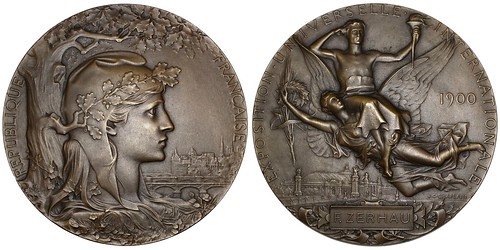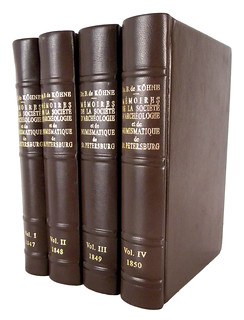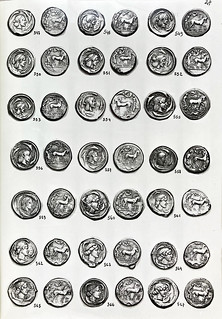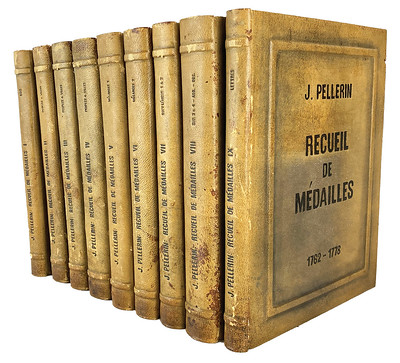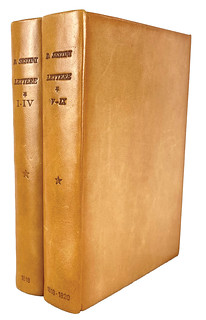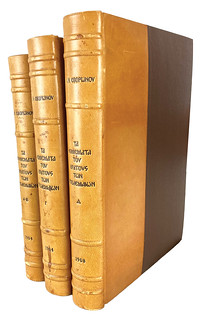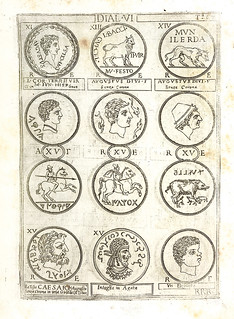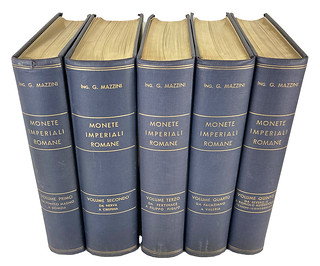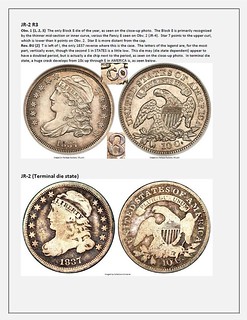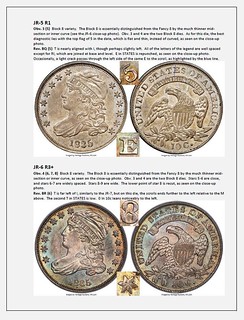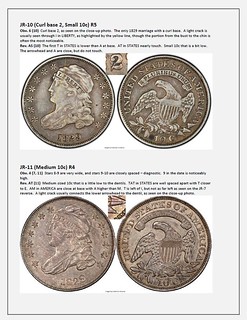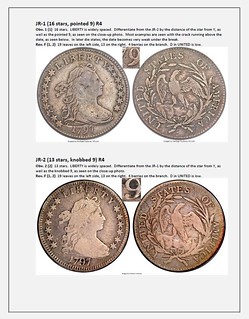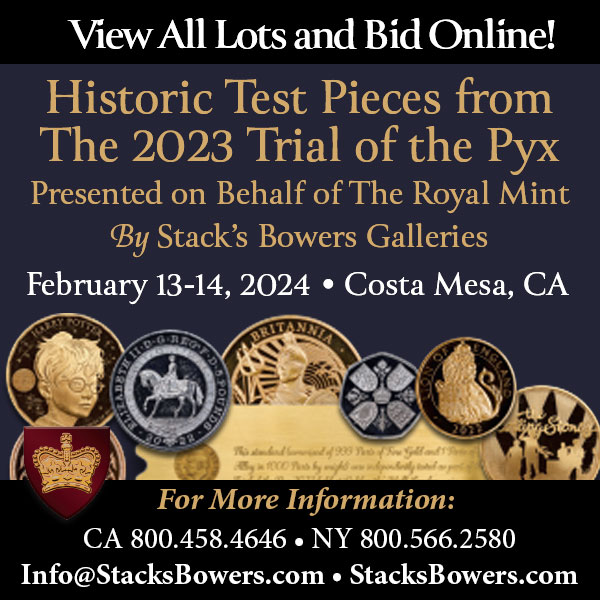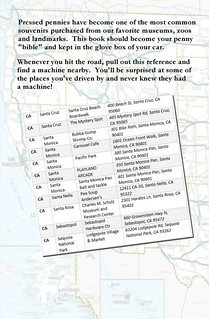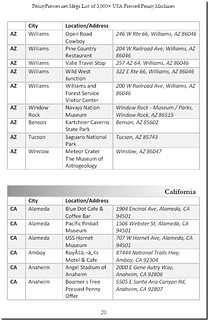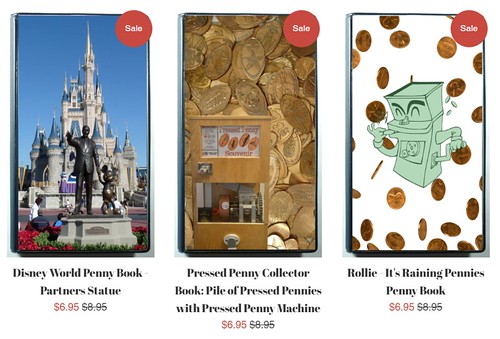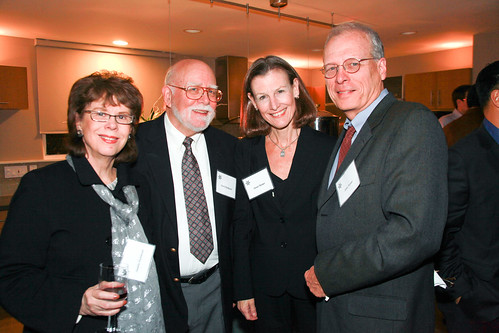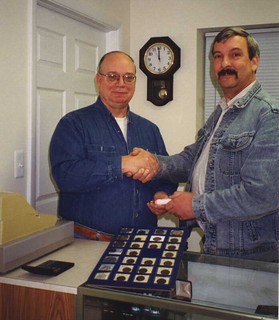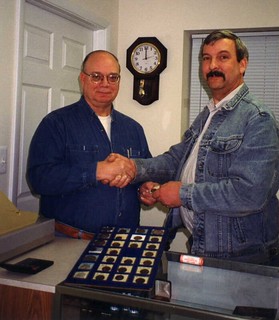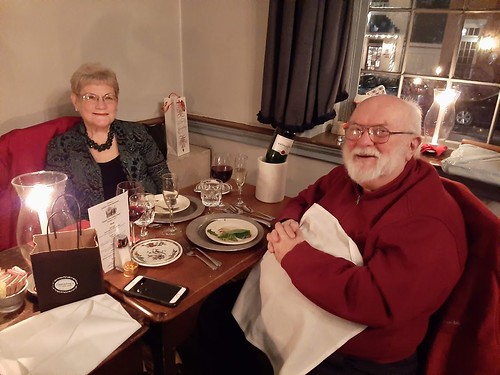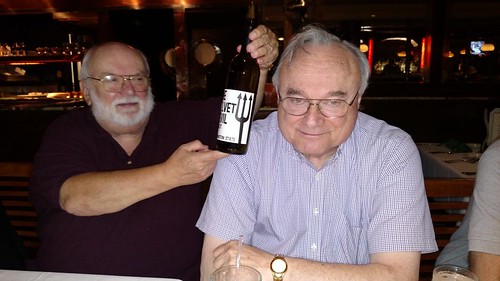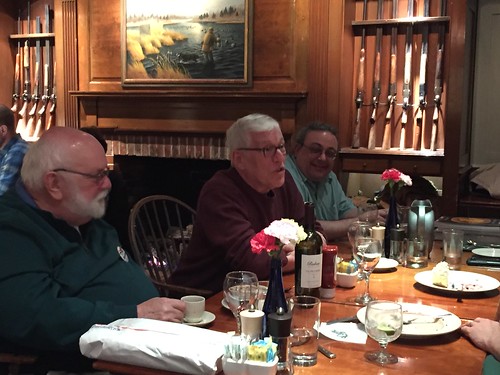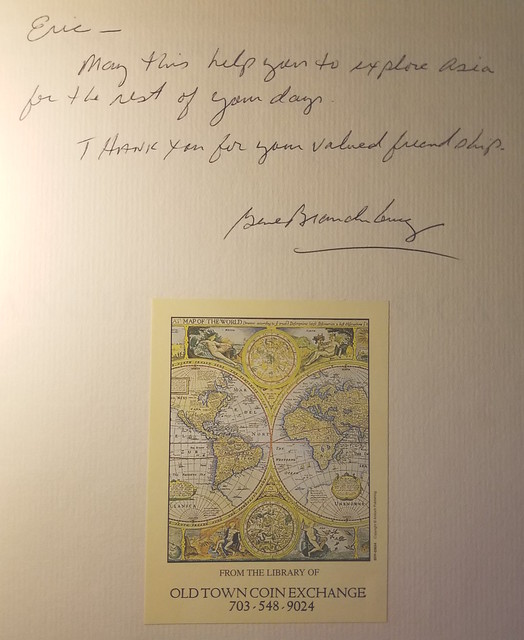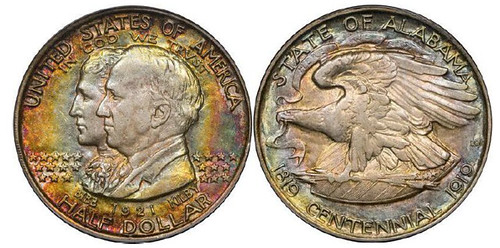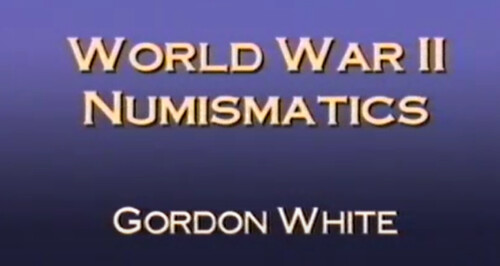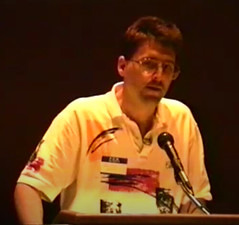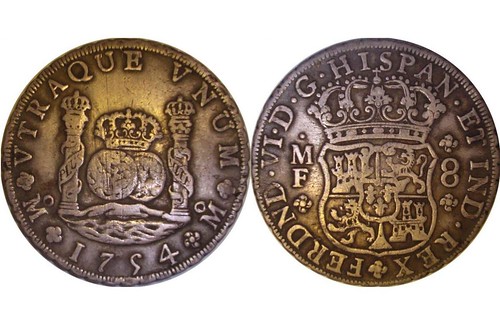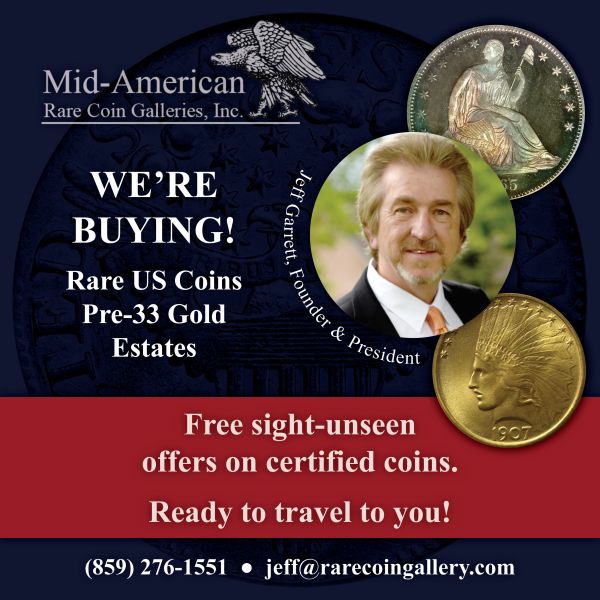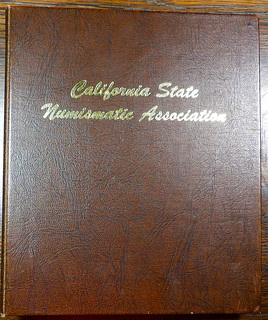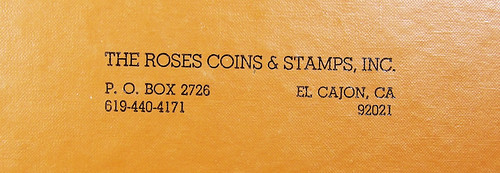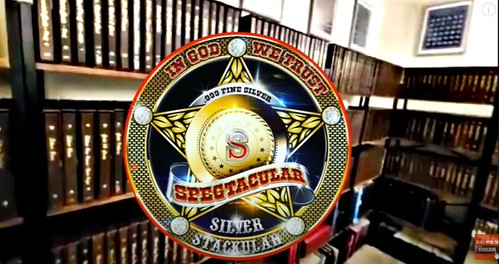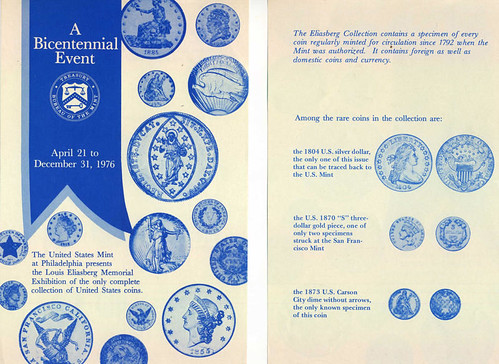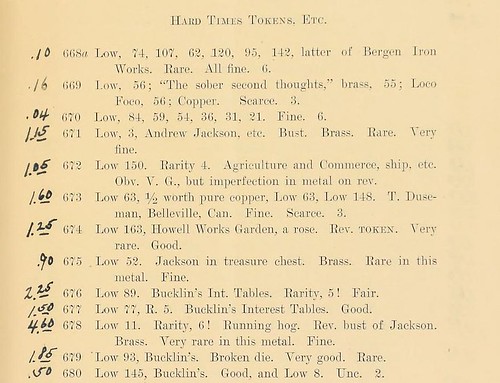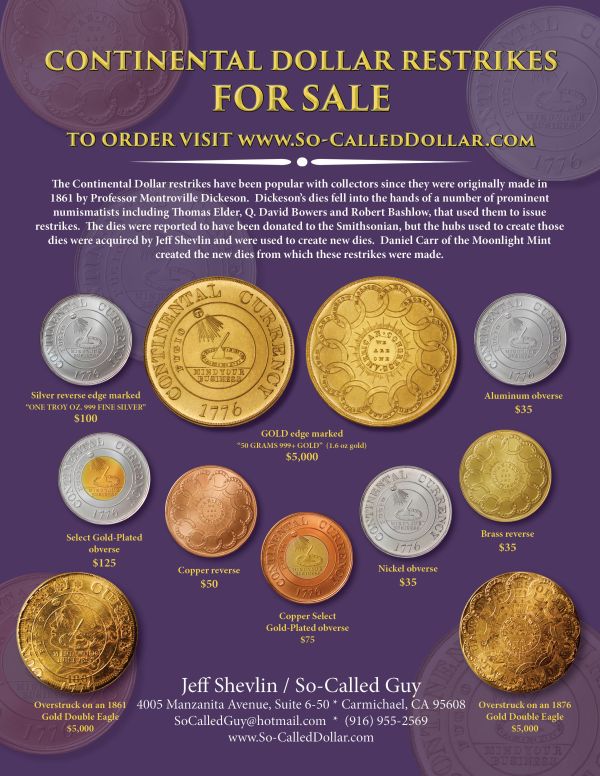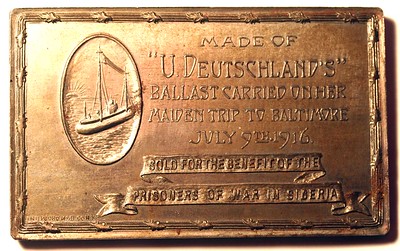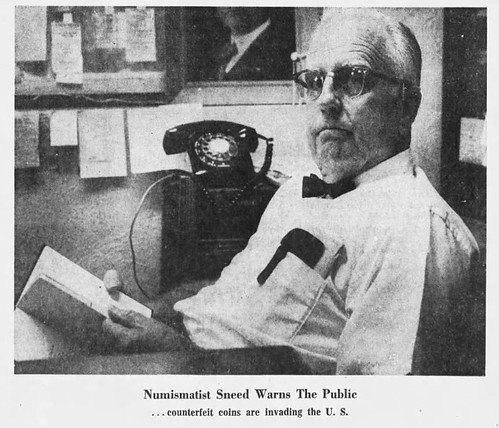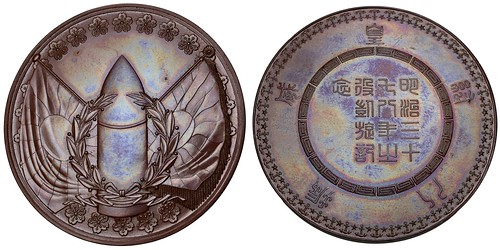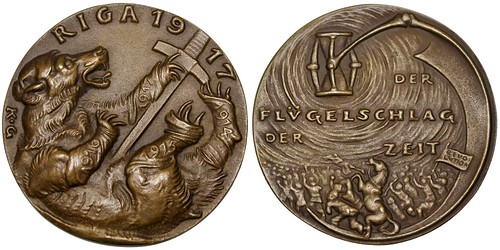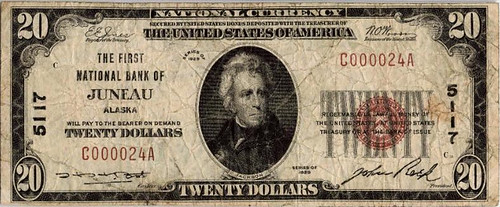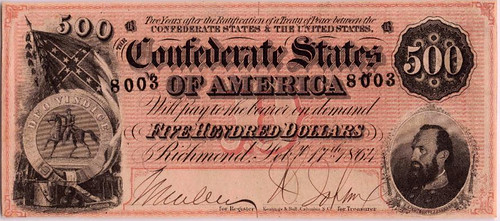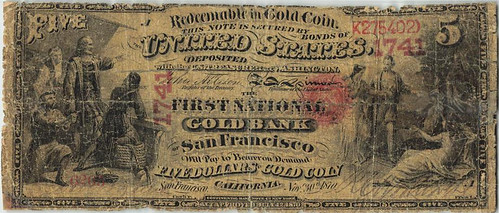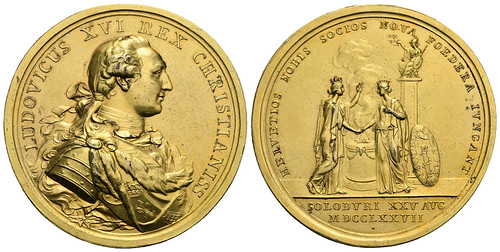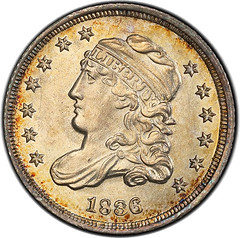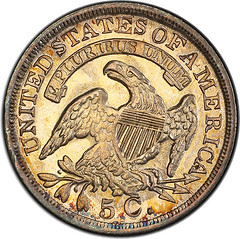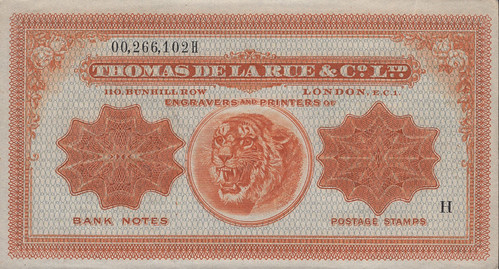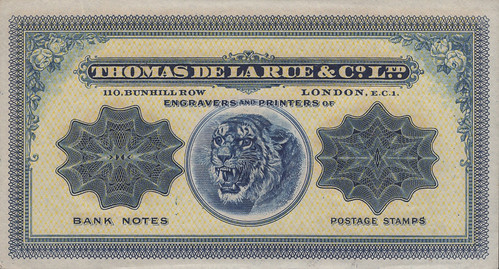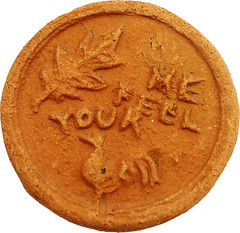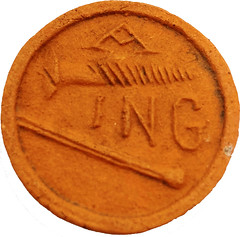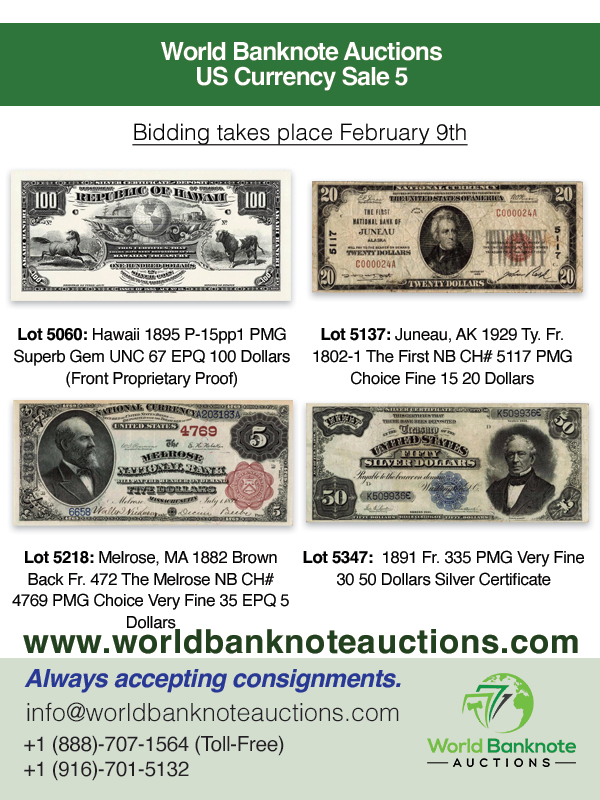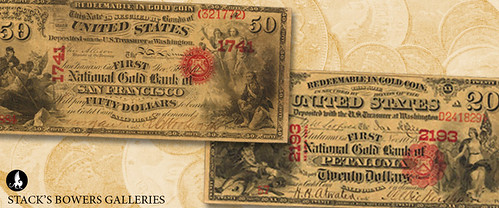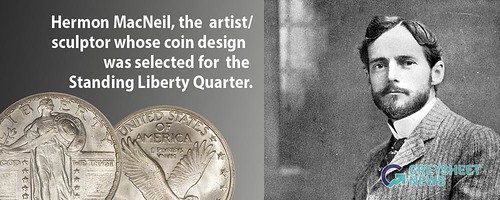
Visit our NBS Sponsors
SubscriptionsThose wishing to become new E-Sylum subscribers (or wishing to Unsubscribe) can go to the following web page link MembershipThere is a membership application available on the web site Membership Application To join, print the application and return it with your check to the address printed on the application. Print/Digital membership is $40 to addresses in the U.S., and $60 elsewhere. A digital-only membership is available for $25. For those without web access, write to: Jeff Dickerson, Treasurer AsylumFor Asylum mailing address changes and other membership questions, contact Jeff at this email address: treasurer@coinbooks.org SubmissionsTo submit items for publication in The E-Sylum, write to the Editor at this address: whomren@gmail.com BUY THE BOOK BEFORE THE COINSale Calendar |
- WAYNE'S WORDS: THE E-SYLUM FEBRUARY 4, 2024
- MORE KOLBE & FANNING BCD LIBRARY HIGHLIGHTS
- FRANK ROBINSON AND BCD
- NEW BOOK: U.S. DIMES 1792-1837
- NEW BOOK: GROVE'S MEDALS OF MEXICO, 3RD ED.
- NEW BOOK: USA PRESSED PENNY MACHINES
- DONALD ERLENKOTTER (1938-2024)
- HARRY W. GARRISON II (1941-2024)
- GENE BRANDENBURG (1942-2024)
- RESEARCH ON U.S. CLASSIC COMMEMORATIVES
- VIDEO: WORLD WAR II NUMISMATICS
- ALEXANDER HAMILTON AND SILVER FINENESS
- MORE ON WILLIAM SUMMER APPLETON
- NOTES FROM E-SYLUM READERS: FEBRUARY 4, 2024
- THE POLITEST AUCTION THAT EVER WAS HELD
- VOCABULARY TERM: PARCEL-GILT
- WILLIAM FRANCIS SNEED JR. (1912-1979)
- NUMISMAGRAM MEDAL SELECTIONS: FEBRUARY 4, 2024
- WBNA US CURRENCY SALE FIVE HIGHLIGHTS
- NUMISMATIC NUGGETS: FEBRUARY 4, 2024
- GEORGE OHR: THE MAD POTTER OF BILOXI
- THE NATIONAL GOLD BANKS
- COIN GIFT HOLDERS
- SOTHEBY'S REVAMPS BUYER'S PREMIUMS
- LOOSE CHANGE: FEBRUARY 4, 2024
Content presented in The E-Sylum is not necessarily researched or independently fact-checked, and views expressed do not necessarily represent those of the Numismatic Bibliomania Society.
WAYNE'S WORDS: THE E-SYLUM FEBRUARY 4, 2024
 The new short version of the mailing has proved a success, reaching all of our subscribers. The original full version continues to cause problems for many, and with this week's issue we've stopped sending it out.
As always, let me know if you have any questions or problems.
The new short version of the mailing has proved a success, reaching all of our subscribers. The original full version continues to cause problems for many, and with this week's issue we've stopped sending it out.
As always, let me know if you have any questions or problems.
Thank you for reading The E-Sylum. If you enjoy it, please send me the email addresses of friends you think may enjoy it as well and I'll send them a subscription. Contact me at whomren@gmail.com anytime regarding your subscription, or questions, comments or suggestions about our content.
This week we open with more BCD library highlights, three new books, three obituaries, notes from readers, updates from the Newman Numismatic Portal, and more.
Other topics this week include medals of Mexico, "pressed penny" machines, U.S. commemorative coins, WWII numismatics, William Sumner Appleton's bookshop discovery, dealer William Sneed, fixed price and auction previews, National Gold Banks, coin gift holders, and buyer's premiums.
To learn more about Revue Numismatique, Don Erlenkotter, Harry Garrison, Gene Brandenburg, the fineness of the silver in early U.S. coinage, "The World's Largest Coin Collection," the Fall of Riga medal, the mad potter of Biloxi, and the politest auction ever held, read on. Have a great week, everyone!
Wayne Homren
Editor, The E-Sylum
MORE KOLBE & FANNING BCD LIBRARY HIGHLIGHTS
Here are some additional highlights of the Kolbe & Fanning sale of the BCD Library. -Editor
Kolbe & Fanning Numismatic Booksellers will be holding our first sale of material from the extraordinary BCD Library on the coinage of antiquity on Saturday, February 17. Formed over the course of half a century, the BCD Library is known for the remarkable breadth and depth of its holdings, which focus most particularly on ancient Greek coinage. The initial auction, which can be accessed at bid.numislit.com, primarily focuses on published collections, general works, periodicals, and landmark publications.
Some highlights include:
Lot 112: the first four volumes of the rare Mémoires de la Société d'Archéologie et de Numismatique de St. Pétersbourg (1847–1850), edited by Bernhard de Köhne
Lot 297: an extraordinary set of seven volumes of bound offprints and extracts of important articles by J.N. Svoronos, many of them rarely encountered
Lot 114: an excellent set of the Revue numismatique, founded in 1836, incorporating the partial set from the library of Hans von Aulock
Lot 335: an original set of the 58 photographic prints comprising the photographic record of the Charles Gillet collection, featuring images of 1217 coins
Lot 384: original printer's proofs of the plates prepared for Dieudonné's catalogue of the Samuel Pozzi collection, one of the great unfinished numismatic projects, the only set in private hands and of tremendous importance
Lot 378: Joseph Pellerin's numismatic magnum opus, Recueil de médailles (1762–1778), complete in twelve parts, as bound in nine volumes
Lot 399: the scarce final edition of Domenico Sestini's complete nine-volume compendium recording European coin collections
Lot 556: an original set of Svoronos's rare and important work on Ptolemaic coins, complete in four volumes as bound in three, with all 68 plates
Lot 557: the 1592 Italian translation of Antonio Agustin's Dialogos de medallas, with 70 engraved plates depicting ancient Roman coins, in a contemporary binding
Lot 567: Giuseppe Mazzini's 1957–1958 Monete Imperiali Romane, in five volumes with a total of 531 excellent photographically printed plates.
Register early to bid online
Bids may be placed via post, email, phone, as well as online. Kolbe & Fanning use Auction Mobility as our third-party online bidding platform. Auction Mobility is an app-based platform allowing users the ability to participate in the sale through phones, tablets and computers. To register for the sale, bidders must go to
bid.numislit.com and sign up. Once you have set up an account, you may browse lots, place advance bids, or participate in the live sale online. Those wishing to participate on their devices can download the Kolbe & Fanning app through the Apple or Google Play Store. The sale has also been listed on Biddr and NumisBids.
To bid and view lots, see:
https://bid.numislit.com/
To view the catalogue PDF, see:
https://numislit.cdn.bibliopolis.com/images/upload/sale169-bcd-small.pdf
The printed catalogue has been mailed to all active customers on our mailing list. As international mail speeds have been inconsistent, we encourage our foreign clients to consult the electronic catalogue in case their printed catalogue does not arrive promptly. A PDF of the printed catalogue has been posted to our main website at numislit.com for those who prefer that format. Bids placed via post, email, or phone must be received by February 16, the day before the sale, in order for them to be processed. Advance absentee bids may also be placed at any time online at bid.numislit.com. Live internet bidding will be available during the sale itself through the same platform.
Kolbe & Fanning Numismatic Booksellers LLC is a licensed and bonded auction firm in the State of Ohio, and our sales are conducted by licensed auctioneers. For more information, please see the Kolbe & Fanning website at numislit.com or email David Fanning at df@numislit.com. To register for the sale, go to bid.numislit.com. We look forward to your participation.
To read the earlier E-Sylum articles, see:
KOLBE & FANNING BCD LIBRARY SALE
(https://www.coinbooks.org/v27/esylum_v27n03a03.html)
KOLBE & FANNING BCD LIBRARY HIGHLIGHTS
(https://www.coinbooks.org/v27/esylum_v27n04a02.html)
FRANK ROBINSON AND BCD
Frank Robinson published an article about the BCD library sale on his blog, The Rational Optimist. Here's a lengthy excerpt - see the complete article online. -Editor
The BCD Numismatic Library Sale, and Human Endeavor
Coin collecting might seem a very solitary pastime; the coins themselves mere objects. Yet for me its rewards have been not just interior, intellectual (and financial), but also very human in its interactions and relationships.
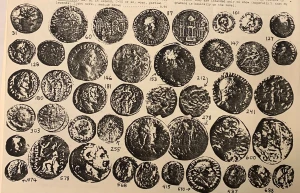 Forty years ago, I started ancient coin sales. With a xeroxed listing, illustrated by just putting a few coins on the copier. The crappiest images imaginable.
Forty years ago, I started ancient coin sales. With a xeroxed listing, illustrated by just putting a few coins on the copier. The crappiest images imaginable.
A letter from someone in Greece requested the catalog, making it sound like those few pitiful pictures were somehow important. I thought he must be a weirdo.
But that was BCD
— he likes to be kind of anonymous — who I eventually learned is in fact the greatest collector ever of ancient Greek coins. Not only collecting them, but building the world's greatest library devoted to them. Open to other researchers, as a resource for study of every minute variation, thus seeking to include every publication that ever illustrated an ancient Greek coin. Hence his interest in my own humble productions. BCD's quest left no stone unturned.
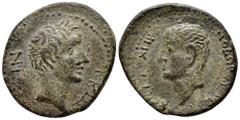 He became a regular correspondent, a sometime coin buyer, and I'd often ship him boxfuls of publications I'd acquired.* He even sent me a few coins to sell for him. (I remember a dual portrait bronze of Octavian and Zenodoros, a local potentate in Chalkis, rather uncommon, that fetched a strong price.) When in 1992 I mentioned a forthcoming tourist trip to Greece, he invited us to visit. I recall eagerly sharing this exciting news with my wife — just as she was sharing hers of a positive pregnancy test!
He became a regular correspondent, a sometime coin buyer, and I'd often ship him boxfuls of publications I'd acquired.* He even sent me a few coins to sell for him. (I remember a dual portrait bronze of Octavian and Zenodoros, a local potentate in Chalkis, rather uncommon, that fetched a strong price.) When in 1992 I mentioned a forthcoming tourist trip to Greece, he invited us to visit. I recall eagerly sharing this exciting news with my wife — just as she was sharing hers of a positive pregnancy test!
So we got to see the actual BCD library. Tucked away in a building in Athens, it was an impressive full-scale facility, employing a full-time librarian, Pat Felch. (My wife was a professional librarian too.) Then the four of us went out to dinner.
Over the decades, I've regularly encountered BCD at the annual New York international coin shows; unfailingly gracious, he's bought some of my (non-numismatic) books and has even posted comments on my blog.
Now well past eighty, his coins were pretty much all sold over the years, with some major auctions (spread among many different firms) each devoted to just one Greek locale.
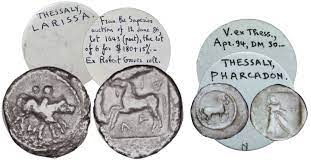 The collection was immense; when I visited Classical Numismatic Group in Pennsylvania, a top ancient coin company, I was shown a cabinet taller than me and told it contained all BCD coins. Recognizable by his meticulously hand-written identifying tags — so frequently found with coins of Larissa, in particular, that in my own auctions I'll sometimes write up a Larissan piece saying
The collection was immense; when I visited Classical Numismatic Group in Pennsylvania, a top ancient coin company, I was shown a cabinet taller than me and told it contained all BCD coins. Recognizable by his meticulously hand-written identifying tags — so frequently found with coins of Larissa, in particular, that in my own auctions I'll sometimes write up a Larissan piece saying NOT ex-BCD and rare thus!
Still it was a shock to see announcement of the BCD Library Sale. By Kolbe & Fanning, the leading numismatic booksellers. I can't begin to imagine what was involved in transporting this huge library from Athens to Ohio where K&F operates.
* There was a cheap seamail rate. Today it's prohibitively expensive.
To read the complete article, see:
The BCD Numismatic Library Sale, and Human Endeavor
(https://rationaloptimist.wordpress.com/2024/01/31/the-bcd-numismatic-library-sale-and-human-endeavor/)
NEW BOOK: U.S. DIMES 1792-1837
Robert Powers has published the latest book in his series of variety & die state attribution guides. It's available from David Kahn Rare Coins. -Editor
U.S. Dimes 1792-1837 Variety Identification Guide
by Robert Powers
$95.00
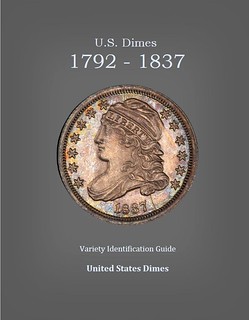 Proudly presented to you is the 8th publication of a series of variety identification guides covering Early U.S. Coins. This book covers all of the currently known die marriages of the U.S. Dimes series from 1792-1837. A complete list of all of the author's previous publications to date are below, which are highly recommended:
Proudly presented to you is the 8th publication of a series of variety identification guides covering Early U.S. Coins. This book covers all of the currently known die marriages of the U.S. Dimes series from 1792-1837. A complete list of all of the author's previous publications to date are below, which are highly recommended:
1. U.S. Large Cents 1793-1814 (Early Date Large Cents)
2. U.S. Large Cents 1816-1839 (Middle Date Large Cents)
3. U.S. Half Cents 1793-1857 (Complete Series)
4. U.S. Half Dollars 1794-1807 (Flowing Hair and Draped Bust)
5. U.S. Half Dollars 1807-1826 (Capped Bust Halves, Vol. 1)
6. U.S. Half Dollars 1827-1836 (Capped Bust Halves, Vol. 2)
7. U.S. Half Dimes 1792-1837 (Flowing Hair, Draped, and Capped Bust)
8. U.S. Dimes 1792-1837 (Draped Bust and Capped Bust)
9. U.S. Quarters 1796-1838 (Draped Bust and Capped Bust)
The primary focus of this guide is to have you quickly and efficiently attributing your Draped Bust and Capped Bust Dimes. That used to be no easy task, but we've made it far easier than ever before with our down-to-Earth system focusing on naked eye observations (photo memory recall), dentil alignments, close-up photos, as well as clearly illustrated die cracks which we have augmented with lines drawn in order to make them easy to see. The large, full color, modern, ultra-high resolution photos found within were carefully selected for these purposes.
The author of this book has had a strong interest in Early U.S. coins for over 30 years. He set out to write this series of books because he has wanted to read them for many years, and finally gave up on waiting for someone else to write them.
Good luck!
In his February 2024 Rare Coins News and Newps email to clients, Dave Kahn penned these thoughts about variety attributions and Robert's books. -Editor
"Robert is a good friend of DKRC and a serious student of early American coinage, who has written, and continues to write interesting Variety Identification Guides for US Flowing Hair, Draped and Capped Bust coin series. He has just released the Bust dime book, 1792 thru 1837, which nearly completes all the copper and silver. The final volume in this series will be Bust quarters, coming fairly soon.
"Robert's books are purely die variety attribution manuals, and I find it quite interesting to see his take on things. A fresh look at attribution methods can work wonders, as I know very well. Back when I started collecting Bust halves by Overton seriously, around 1984, I set out to memorize Overton. By the late 80's, when I met Dr. Michael Summers, who quickly became my primary mentor in that series, I had made lots of progress. But Mike showed me a different way to look at the coins, and for me, his way was not only faster and more effective, it was easier too.
"So it is with Robert Powers. He takes a little different path. Yes, I already know much of what he has put in print, but not all, and it's those little nuggets that can be valuable. If you haven't seen any of Powers' books, I suggest you try one. He very likely has written one on your favorite series. I can't wait to see what he'll have coming next!"
For more information, or to order, see:
U.S. Dimes 1792-1837 Variety Identification Guide, by Robert Powers
(https://www.davidkahnrarecoins.com/u-s-dimes-1792-1837-variety-identification-guide-by-robert-powers.html)
NEW BOOK: GROVE'S MEDALS OF MEXICO, 3RD ED.
Matt Ruttley writes:
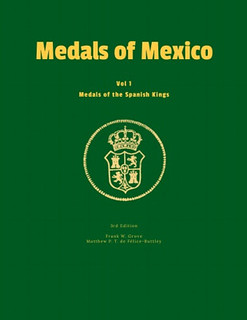 "I've been working with the family of Frank W. Grove, who wrote the standard reference on Mexican Medals - just referred to by auctioneers/slabbers as "Grove" or "Gr".
"I've been working with the family of Frank W. Grove, who wrote the standard reference on Mexican Medals - just referred to by auctioneers/slabbers as "Grove" or "Gr".
"Despite being the standard reference, they are really annoyingly inaccessible to the new collector at $850 for a set (if even available at all) as they have been out of print since the 80s. The family have given me permission to republish them so I've put together a new edition of Volume 1; Vols 2, 3, 4 and potentially Tokens book to follow.
"This new edition has updated color photos for all the medals that have sold at auction since the 80s, which is a very substantial amount. Many were previously thought to be lost and just represented by sketches or grainy black and white pics from catalogs.
"The new edition is also paperback and very affordable for new collectors at $35 (compared to at least $150-200 for the hardback original)."
That's great news! Here's the press release. -Editor
International Fine Objects presents:
Finally an affordable edition of Grove's Medals of Mexico! Re-published in paperback after 40 years out of print, with permission of the Grove family:
- Volume 1 available now
- Covers colonial medals (especially proclamations) of Mexico, Honduras, Guatemala and El Salvador
- The standard reference used by grading companies and major auction houses
- 200+ colour images replace grainy black and white photos and sketches
- A new tribute obituary to Frank Grove
Available for only $35 including shipping within the USA! Order by emailing: sales@ifobjects.com.
ISBN: 979-8-9888531-1-4
Format: 8.5x11, Paperback, 216 pages
Publication date: Dec 28th 2023
Frank Grove's herculean lifetime effort to catalogue the medals of Mexico has stood the test of time, remaining the standard reference for collectors, auctioneers and graders for over 40 years. Medal collecting has surged in popularity, but being out-of-print, his books have become increasingly unobtainable for new collectors. Since the advent of the internet, many previously un-photographed medals have also come to light. Some are so rare that Grove never saw them in person, having to copy hand-drawn sketches from prior works by Medina and Herrera. This new 3rd edition updates the reader with hundreds of high resolution colour images from recent auctions and aims to give new collectors an insight into this wonderful area of Mexican history.
For more information and other publications, see:
International Fine Objects
(https://www.ifobjects.com/?page=coin_books_for_sale)
NEW BOOK: USA PRESSED PENNY MACHINES
Apparently it's already out of print, but I just came across this book on elongated cent press machines around the U.S. -Editor
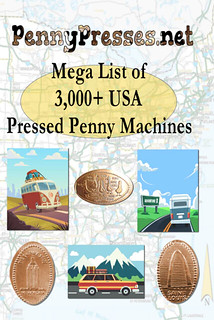 Mega List of 3,000+ USA Pressed Penny Machines
Mega List of 3,000+ USA Pressed Penny Machines
Pressed pennies have become one of the most common souvenirs purchased from our favorite museums, zoos and landmarks. With over 3,000 machines listed all over the United States, this book should become your penny bible
and kept in the glove box of your car. Whenever you hit the road, pull out this reference and find a machine nearby.
- The perfect size to keep in your car, purse or backpack
- Over 200 pages of pressed penny machines found in every state
- Organized alphabetically by State and City
- Plenty of space for comments in the Notes section
- Easy to clean, glossy cover allows planning at meal time
- Every State is listed (including Alaska and Hawaii)
This book is your essential planning tool when heading out on vacation, road trips or just a family day trip. Makes a great gift! Keep one in each of your cars so you'll never be without it.
For more information, see:
Mega List of 3,000+ USA Pressed Penny Machines
(https://pennypresses.com/products/mega-list-of-3-000-usa-pressed-penny-machines)
The publisher also sells "penny book" holders for storing elongated cent collections. -Editor
DONALD ERLENKOTTER (1938-2024)
Born August 3, 1938, Donald Erlenkotter of Santa Monica, California passed away on Sunday, January 14, 2024 aged 85. Thanks to David Gladfelter for passing the word. -Editor
David Gladfelter writes:
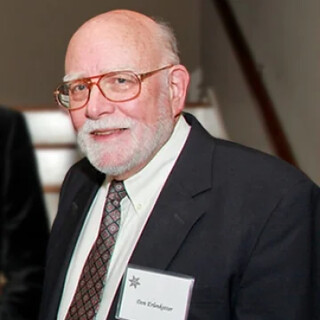 "I wanted to be sure that you knew about the passing of Donald Erlenkotter, president of the Civil War Token Society from 2009 to 2011 and a frequent contributor to its quarterly journal. He was professor emeritus of decisions, operations and technology management at the University of California at Los Angeles Anderson School of Management. His widow, Sandra Hunnicutt, said he had suffered from Alzheimer's – this will evoke nothing but sympathy and the Society's journal, now titled Civil War Era Numismatics to reflect its broadening focus beyond tokens, is planning a special issue later this year about him."
"I wanted to be sure that you knew about the passing of Donald Erlenkotter, president of the Civil War Token Society from 2009 to 2011 and a frequent contributor to its quarterly journal. He was professor emeritus of decisions, operations and technology management at the University of California at Los Angeles Anderson School of Management. His widow, Sandra Hunnicutt, said he had suffered from Alzheimer's – this will evoke nothing but sympathy and the Society's journal, now titled Civil War Era Numismatics to reflect its broadening focus beyond tokens, is planning a special issue later this year about him."
His 2012 entry in the Civil War Token Society Hall of Fame:
"Donald Erlenkotter has contributed more to the Civil War Token Society in every aspect than any other member in the recent past. He has received 2 service awards, 6 literary awards, served on the Board of Governors and as President in 2009-10. He was interim secretary and membership chairman wherein he rebuilt the membership data base. He served on the Storecard 3 [book] committee, and stepped in to fill the position of Editor and interim Publisher of the Journal in 2010, a position he still holds. He has contributed countless articles to the Journal on both research and historical interest. He compiled the Executive Board Handbook for use by the Officers and Board of Governors of the Society and did extensive work on the by-laws. Don has continuously shown his willingness to assist fellow members with research, encourage authors, and step up to the plate to fill a vacancy on the board due to the death or resignation of an officer."
To read the complete article, see:
CWTS Hall of Fame : Donald Erlenkotter
(http://cwtsociety.com/halloffame.shtml)
John Ostendorf and Larry Dziubek note that while this was all accurate as of 2012, Erlenkotter hasn't been the journal editor for a number of years. -Editor
David Gladfelter adds:
"Don had the habit of circulating drafts of articles he was writing to his friends for review and comment. That way we had the advantage of seeing them months before publication and Don had the advantage of avoiding the few mistakes we might catch. Don was a force in the CWTS, contributing not only his time but expertise as well in creating the executive board manual that we still use and bringing our bylaws into line with practice.
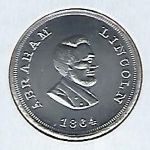 "I have his personal set of CWTS Hall of Fame medals – they were issued in four compositions: copper coated zinc, brass coated zinc, nickel coated zinc, and silver. Here is a pure silver composition, turned to show the reverse die, a copy of the Abraham Lincoln patriotic die 131.
"I have his personal set of CWTS Hall of Fame medals – they were issued in four compositions: copper coated zinc, brass coated zinc, nickel coated zinc, and silver. Here is a pure silver composition, turned to show the reverse die, a copy of the Abraham Lincoln patriotic die 131.
"The medals were struck by the Patrick Mint. The mintage was 100 in each composition. The original of die 131 still exists but was not used to strike the Hall of Fame medals.
"Left to right below are examples of copper coated zinc, brass coated zinc, and nickel coated zinc."
John Ostendorf adds:
"Don was a friend. Don and I collaborated on a great deal of research for which he had quite a passion. He helped me polish up my book on Cincinnati Civil War store cards and we would go on to work on a number of other research projects. He took over as interim Secretary in 2009 or so and overhauled an antiquated system which made my life easier when I took the position in 2011. He served with me on the SC3 book committee where we found opportunities for additional research.
"He and I spent many hours together at the CWTS table at various ANA shows and we could talk Civil War tokens and CWTS business for hours. His articles were always well researched, sources documented, and interesting to read. It was my pleasure to nominate him for induction into the CWTS Hall of Fame. Don received many awards in his professional career and in the CWTS; but I know he took particular pride in his Hall of Fame induction.
"Sadly, Don was stricken by Alzheimer's a few years ago and we could no longer communicate. I miss those days of research collaboration and sitting at the CWTS table with him. Don was a good friend and will be missed by all who knew him."
From the UCLA site:
Biography
Donald Erlenkotter has focused his research and teaching on how mathematical models can be applied to managerial decisions. He has served the UCLA Anderson School of Management as chairman and associate dean for academic affairs, and has held appointments with the Agency for International Development, the European Institute for Advanced Studies in Management and the International Institute for Applied Systems Analysis. He is a founder of the Production and Operations Management Society.
In 1994–95, Erlenkotter was a senior fulbright scholar at Kathmandu University in Nepal. He has studied, worked and taught in the developing markets of East Asia, including India, Iran and Nepal.
Education
Ph.D. Management Science, 1970, Stanford University
M.S. Statistics-Operations Research, 1964, Stanford University
MBA Management Science, 1963, Stanford University
BCE, 1960, Georgia Institute of Technology
To read the complete article, see:
Donald Erlenkotter
(https://www.anderson.ucla.edu/faculty-and-research/decisions-operations-and-technology-management/faculty/erlenkotter)
FUN FACT:
Charles Erlenkotter
A few weeks ago I received an e-mail from Donald Erlenkotter, Professor Emeritus of Management at UCLA's Anderson Graduate School of Management (and former fellow Stanford student—M.B.A., M.S., and Ph.D.!). Charles Erlenkotter, whose February 15, 1942, puzzle was the first crossword ever published in The New York Times, was Don's great-uncle.
To read the complete article, see:
The Pre-Shortzian Puzzle Project
(http://www.preshortzianpuzzleproject.com/2015/11/)
HARRY W. GARRISON II (1941-2024)
New Jersey dealer Harry Garrison has passed. Here's an excerpt from his online obituary. -Editor
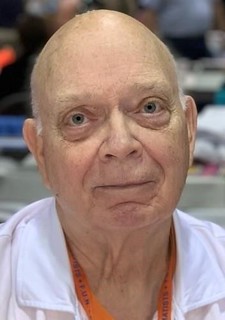 Harry (Bud) W. Garrison, 82, of Cream Ridge, passed away Wednesday, January 3, 2024 from pancreatic cancer. Born in Trenton, Harry graduated from Hamilton High East and Marywood College and served in the US Army. He worked for McGraw Hill for 38 years, retiring in 2000. An avid coin collector, Harry turned his hobby into a career when he opened Colonial Valley Coins in Yardville. He sold the business in 2023. He was a long-time member of the Trenton Numismatic Club. Harry also enjoyed fishing, boating, and trips to "the lake" in Canada.
Harry (Bud) W. Garrison, 82, of Cream Ridge, passed away Wednesday, January 3, 2024 from pancreatic cancer. Born in Trenton, Harry graduated from Hamilton High East and Marywood College and served in the US Army. He worked for McGraw Hill for 38 years, retiring in 2000. An avid coin collector, Harry turned his hobby into a career when he opened Colonial Valley Coins in Yardville. He sold the business in 2023. He was a long-time member of the Trenton Numismatic Club. Harry also enjoyed fishing, boating, and trips to "the lake" in Canada.
Son of the late Harry and Ruth Garrison, he was predeceased by his brother, Robert Garrison. Harry is survived by his loving wife of 62 years, Judith A. Garrison, his children, Deborah Garrison, Wesley Garrison and his wife, Veronica, Jacob Garrison and his wife, Melissa, and Asia Garrison; his grandsons, Jacob Garrison, William Garrison, Connor Guarniere, and Chase Garrison; his sister, Lorraine Wilson and her husband, Lynn as well as many nieces and nephews.
Ray Williams writes:
"He was a local coin dealer who opened Colonial Valley Coins after retiring. I don't think there was a collector in New Jersey that didn't know Harry."
Ray and his wife Diane shared this article she wrote some 24 years ago about one of Ray's transactions with Harry. Thanks. -Editor
A Numismatic New Year
By Diane Williams (Mrs. Ray Williams)
The time is 11:59:55 PM on December 31, 1999. The end of the century – the end of the second millennium! Where do I find myself on this momentous occasion? In Times Square watching the ball drop? Hardly! At a festive party, with family and friends, watching the ball drop on TV? Not exactly… I find myself in the not-quite-open-for-business, new location of Colonial Valley Coins, camera poised and ready to record a transaction between my husband, Ray Williams and the proprietor, Harry Garrison. A small transaction, Ray selling Harry a roll of Connecticut quarters, but a transaction none the less. The last of the millenium? Perhaps...
Seventeen seconds later, 12:00:12 AM on January 1, 2000, as the sound of the town fireworks echo through the windows and the TV in the next room faintly delivers the celebration in Times Square, my camera is flashing again. This time it's Harry selling Ray an R6 Connecticut Copper (M14.2-A.2 for all Ray's Colonial friends). The first transaction of the new millenium? It's hard to say.
I can't help but imagine that at 12:00:12 AM GMT in a little coin shop overlooking the Thames, that some British coin collector and his dealer friend are conducting similar business with the bright flashes of the London fireworks display lighting up the shop through the windows. Or maybe a couple of hours earlier, a tiny shop in the narrow streets of Bethlehem has two numismatists huddled over a counter conducting their business with an eye on the clock and making history.
But whether the actual last and first numismatic transactions of 1999 and 2000 in the world or not, I know this much –If nothing else, they were the last and first millennial transactions in Hamilton, NJ! And perhaps the way I spent New Year's Eve 1999 wasn't in the most festive or exciting or traditional manner, but it made two really nice guys smile from ear to ear, so I can't think of a better way to start the next millennium!
To read the complete online obituary, see:
Harry W. Garrison II
(https://obits.nj.com/us/obituaries/trenton/name/harry-garrison-obituary?id=54042098)
GENE BRANDENBURG (1942-2024)
Dave Schenkman notified me that our good friend Gene Brandenburg has passed. Born May 5, 1942, he was 81. -Editor
Dave writes:
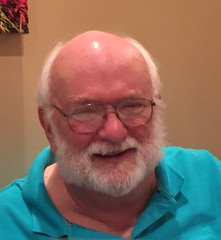 "I was saddened to learn that my friend of many years, Gene Brandenburg, died on January 31 at the age of 81, following a battle with cancer. I met Gene shortly after moving to Maryland in 1970, and we became good friends. We both eventually became coin dealers, and although we were never in business together, we shared tables at many Washington area conventions. I have fond memories of collections we purchased jointly, but the most memorable of them had nothing to do with coins; it was a group of 68 old slot machines we bought and sold the same day.
"I was saddened to learn that my friend of many years, Gene Brandenburg, died on January 31 at the age of 81, following a battle with cancer. I met Gene shortly after moving to Maryland in 1970, and we became good friends. We both eventually became coin dealers, and although we were never in business together, we shared tables at many Washington area conventions. I have fond memories of collections we purchased jointly, but the most memorable of them had nothing to do with coins; it was a group of 68 old slot machines we bought and sold the same day.
"Gene was a very generous person. I recall one year when he pulled up to my garage unexpectedly, honked his horn and told me to open the door. I did so, and he unloaded a dozen cases of Christian Moerlein, a Cincinnati beer that he knew I liked. The beer wasn't sold locally, but somehow he found it; he really enjoyed surprising friends with gifts.
"Old Town Coin and Jewelry Exchange, Gene's shop was a fixture of Alexandria, Virginia for decades. He loved to buy unusual items, so there was always something new when I stopped by. He loved the business, and even after closing his shop he maintained a presence in Alexandria by renting space in an antique mall, where he could be found a couple of days a week.
"Gene was a member of Nummis Nova, a dinner group that meets monthly, and we always drove to the restaurants together. The return trips usually included conversations about the items passed around by members, and no matter whether they were U.S. and foreign coins, or tokens, medals, and obsolete currency, if they were unusual or rare Gene was interested in them.
"My wife, Joanne, and I were often guests at his home for his family's Thanksgiving dinner, and we treasure these memories. Gene was a very special person, and he will be missed."
So sorry to hear the news. Gene was indeed generous and gregarious. We always had interesting conversations at our dinner meetings about numismatics and any other topic under the sun. Here are some selected photos from our meetings. -Editor
In August 2015 Eric Schena wrote about Gene as his numismatic mentor. -Editor
"I have been in numismatics ever since I was four years old. I have been especially fortunate in that I have had some outstanding mentors throughout much of that time. When my family moved to Northern Virginia in 1984, I met Gene Brandenburg at his shop at 211 King Street in Alexandria and quickly became a regular. He took me under his wing and I learned an enormous amount about the coin business and, rather importantly, awoke a passion in me to research the less traveled paths in numismatics.
"At the time, Gorbachev and glastnost helped to open new avenues of research regarding early and medieval Russian coins and thanks to Gene I was able to start assembling a nice collection of "wire" coins. I also took an interest in ancient coins and in particular the mysterious coins of ancient and medieval Central Asia. When I started to work part time for Gene, he helped me learn how to attribute the coins with barely any starting information. I cut my teeth on these coins using Michael Mitchiner's Oriental Coins and Their Values (which he recently gave to me) and enjoyed every minute of it.
"In college in the early 1990s, I minored in Russian Studies (though when I started it was called Soviet Studies) and used my interest in wire coins to write my senior thesis on them. His location in Alexandria also meant a number of great local items came through his shop and with one obsolete note in particular, a 12 1/2 cent note from A. Henkel & Son, I began my journey into the world of tokens and paper money of the Mid Atlantic.
"He also introduced me to Nummis Nova and the tremendous fun of that as well as another person whom I consider one of my most influential mentors as well as great friend, Dave Schenkman.
"I am forever grateful to Gene for taking the time to mentor me into what has proven to be an essential part of my life. I'm a firm believer in the power of mentoring and that it really never ends. Gene and Dave have really helped to hone my researching skills and keep my passion and interest in numismatics constant and continue to do so. If I become even one-tenth the numismatist they are then I will consider my career a success. I certainly hope to be a mentor myself and help a young numismatist's interests flourish and give back to the hobby that has given so much to me."
Eric adds:
"I have always maintained that working for Gene was the most rewarding and best employment experience I ever had. Not only was I able to be exposed to a wide range of numismatic material every day I was there and learn something new, Gene was about as best a boss anyone could have. When he had his shop down on Alexandria's waterfront on S. Union St., every Saturday night, we'd close up the shop and put everything away, then he'd insist we go down to the lower level in the shop where he kept a desk by the front window. There, he'd find some stunning bottle of wine (and we're not talking 2 Buck Chuck here) and we'd empty that bottle talking about everything and anything.
"This time of year was port season on his wine calendar and one evening he grabbed a bottle of 1977 Warre's Vintage Port and he poured it through a coin silver strainer made in the 1790s in Baltimore specifically for this purpose. That was just one of many such special memories that I will carry for the rest of my life. I will get a nice vintage bottle of port and salute my dear friend. Bon voyage et laissez les bon temps rouler, mon ami."
In an October 2014 profile, we learned more. -Editor
"[Eric] spent many hours researching and attributing Greek and Roman coins at Gene Brandenburg's store.. Brandenburg was a mentor who taught Schena about some of the less-traveled paths in numismatics. Schena says, "It is through him that I developed my lifelong passion for collecting tokens and obsoletes from Virginia, starting with a ‘good for' token from the Southern Operating Company of Norfolk, a piece still in my collection.""
Lorne LaVertu writes:
 "I've only been with the group two (2) years, and so, never had the pleasure of personally meeting Gene at a Nummis Nova dinner; that said, I was a big collector of wine paraphernalia in the 1980's/1990's, and visited his shop on a number of occasions. On one occasion, he had a stack of five (5) silver tastevins to the side of his counter. I asked him for a price, to which he said that he'd paid spot silver and would sell them to me at a 10% markup. I told him what they were, and that they were worth considerably more, to which he replied, "spot, plus ten percent." OK, I said, and the deal was consummated.
"I've only been with the group two (2) years, and so, never had the pleasure of personally meeting Gene at a Nummis Nova dinner; that said, I was a big collector of wine paraphernalia in the 1980's/1990's, and visited his shop on a number of occasions. On one occasion, he had a stack of five (5) silver tastevins to the side of his counter. I asked him for a price, to which he said that he'd paid spot silver and would sell them to me at a 10% markup. I told him what they were, and that they were worth considerably more, to which he replied, "spot, plus ten percent." OK, I said, and the deal was consummated.
"These tastevins still reside in my collection of silver wine tastevins. For me, his legacy lives on in a very tangible form.
"May he truly rest in peace."
For more information, see:
What is the tastevin?
(https://www.intornoalvino.com/en/blog/what-is-the-tastevin-n20)
Mike Packard writes:
"Sad news. After Gene stopped attending our dinners, I often asked Dave how Gene was doing and asked him to pass along a greeting from me. I always liked Gene and enjoyed our dinners with him. He always had good stories and something to say about the items being circulated. When it was my turn to host, he always let me know if I'd done well--not by praising the quality of the food he ate but by evaluating the quality of the wine he drank. I received mostly thumbs up and even a couple of "HUZZAH"s, which made me feel good. Farewell good Sir."
In September 2011 Gene brought as his guest Alex Clain-Stefanelli, son of National Numismatic Collection curators Vladimir and Elvira Clain-Stefanelli. Alex worked in Gene's coin shop for a time.
I can attest to Gene's generosity and love of wine - he always insisted on buying a bottle and sharing it with me and others at our dinners. I learned a few things but always leaned on his suggestions and felt lost ordering wine without him. Gene had been ill and unable to join us for dinners in about four years. It hasn't been quite the same since. He is greatly missed. -Editor
Tom Kays writes:
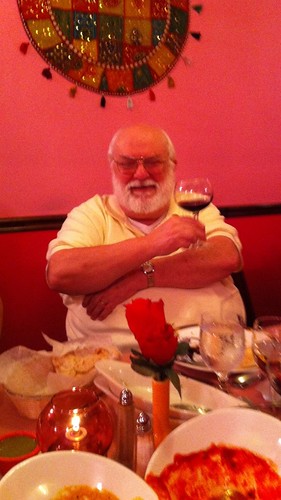 "Here is my friend Gene at his most content, ensconced in a cozy restaurant, surrounded by old friends of Nummis Nova, and fully approving of this red wine choice, with our fabulous dinner. Ready to talk about coins, about vacations, about his children and grandchildren, what I especially enjoyed were his observations about dealing with odd characters like me who came into the Olde Town Coin Exchange with obscure relics and sometimes true tales of numismatic treasures of long ago, now set on his counter for his perusal, divination, and perhaps purchase.
"Here is my friend Gene at his most content, ensconced in a cozy restaurant, surrounded by old friends of Nummis Nova, and fully approving of this red wine choice, with our fabulous dinner. Ready to talk about coins, about vacations, about his children and grandchildren, what I especially enjoyed were his observations about dealing with odd characters like me who came into the Olde Town Coin Exchange with obscure relics and sometimes true tales of numismatic treasures of long ago, now set on his counter for his perusal, divination, and perhaps purchase.
"I would buy anything from this man from rusty nails to old shingles, regardless of whether the stories he spun about where they came from and how they came into his possession were even mildly factual. Historic objects that came from Gene had great stories worth knowing. It was my very great pleasure to sit across from Gene Brandenburg and swap tales at Nummis Nova dinners."
To read online obituaries, see:
Gene Brandenburg
(https://www.arehartechols.com/obituary/Gene-Brandenburg)
Gene Brandenburg
(https://www.legacy.com/obituaries/name/gene-brandenburg-obituary?pid=206258094)
To read the earlier E-Sylum articles, see:
THE NUMISMATIST PROFILES ERIC SCHENA
(https://www.coinbooks.org/esylum_v17n43a19.html)
WAYNE'S NUMISMATIC DIARY: SEPTEMBER 18, 2016
(https://www.coinbooks.org/esylum_v19n38a19.html)
ALEXANDER A. CLAIN-STEFANELLI, 1943 - 2014
(https://www.coinbooks.org/esylum_v18n02a06.html)
WAYNE'S NUMISMATIC DIARY: OCTOBER 14, 2018
(https://www.coinbooks.org/v21/esylum_v21n41a18.html)
WAYNE'S NUMISMATIC DIARY: DECEMBER 22, 2019
(https://www.coinbooks.org/v22/esylum_v22n51a20.html)
RESEARCH ON U.S. CLASSIC COMMEMORATIVES
The latest additions to the Newman Numismatic Portal are research monographs on U.S. commemorative coins by Lee Gast. Project Coordinator Len Augsburger provided the following report. -Editor
Lee Gast Delivers Research on U.S. Classic Commemoratives 206258094)
The constantly progressing availability of information demands the reexamination of old subjects, and, in the realm of U.S. classic commemoratives (1892-1954), Lee Gast has stepped into the void and is producing monographs on the various issues in the series. The recently added Alabama Centennial (1921) installment is typical. Gast pulls documentation from congressional proceedings, the Commission of Fine Arts, and the National Archives, creating a full picture of the coin from conception to realization. The original documents provide authoritative context, and collectors of the series will appreciate the stories behind each individual commemorative issue.
Image: 1921 Alabama Centennial half dollar, Plain variety. Ex. Lee Gast Collection, photography by Mark Goodman.
Great work - check out all of the monographs at the below link. -Editor
Link to Lee Gast publications on Newman Portal:
https://nnp.wustl.edu/library/booksbyauthor/551821
VIDEO: WORLD WAR II NUMISMATICS
The David Lisot Video Library on the Newman Numismatic Portal can be found at:
https://nnp.wustl.edu/library/multimediadetail/522852
We highlight one of his videos each week in The E-Sylum. Here's one from 1995 about World War II Numismatics. -Editor
World War II changed the face of the earth in many ways. Numismatics is one of them. Surprisingly so, this is an area of collecting which is still young and quite affordable. "I absolutely love the historic value of WW II numismatic material!" says White, who has been in numismatics for over two decades. In this video, White will teach you: what economic impact war had on countries and how that is reflected in each country's coinage what was emergency coinage what message the Canadian victory nickel has minted around its rim in Morse code why the famous two reich mark piece was discontinued when the war started about occupation coins about German access military currency German and British counterfeit currency PLUS a few valuable tips on Nazi medal collecting.
Speaker(s): Gordon White.
To watch the complete video, see:
World War II Numismatics
(https://nnp.wustl.edu/library/book/560340)
ALEXANDER HAMILTON AND SILVER FINENESS
Craig Sholley and Harry Salyards submitted this article about their recent research into the fineness of the silver in early U.S. coinage. Thank you. -Editor
Craig Sholley and Harry Salyards
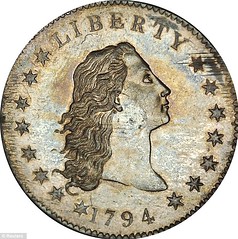 Alexander Hamilton has been criticized by numerous past and present authors for supposedly choosing a wrong gold-to-silver ratio and a wrong standard for the grains of fine silver in a dollar; the latter leading to a clumsy fineness of .8924 for our early silver coinage. One 19th century author was apparently also the source of the tale that while U.S. dollars were significantly lighter than the Spanish dollar, their trading on par in the West Indies led to large deposits of Spanish dollars at the U.S. Mint for recoinage at a profit.
Alexander Hamilton has been criticized by numerous past and present authors for supposedly choosing a wrong gold-to-silver ratio and a wrong standard for the grains of fine silver in a dollar; the latter leading to a clumsy fineness of .8924 for our early silver coinage. One 19th century author was apparently also the source of the tale that while U.S. dollars were significantly lighter than the Spanish dollar, their trading on par in the West Indies led to large deposits of Spanish dollars at the U.S. Mint for recoinage at a profit.
Early this year, Harry Salyards and I began researching these points and found both the criticism and the supposed arbitrage trade completely without merit. Not only did the authors criticizing Hamilton use incorrect period gold-to-silver ratios, along with incorrect weights and fineness standards for the Spanish dollars of the early 1790s, they often used assay figures for either earlier or later date Spanish dollars. And, even then, the data were often misquoted or misrepresented.
The fact is that Hamilton was correct when he quoted various world gold-to-silver ratios. According to period documents, including English Parliamentary records, England's ratio was 15.2:1, just as Hamilton had noted. And, according to the International Monetary Conference of 1878, prices on the London exchange in 1790 to 1792 yield an average of 14.83:1 and those on the Hamburg exchange show a ratio of 15.08:1. Thus, average gold-to-silver ratio on the two major gold and silver exchanges in 1790 to 1792 was 14.95:1 - a figure remarkably close to Hamilton's estimate of 14.8:1.
Nor were Hamilton's assay and estimated fineness figures for the Spanish dollar off by all that much. While the Spanish coinage law of 1772 set the dollar at 417.8 grains and .9028 fine, there was an allowed deficiency in both weight and fineness such that coins from the Mexican mints typically ran 416 grains gross and contained just 374 grains of fine silver. Additionally, period English, French, and American assays show the average Spanish dollar in circulation was not only underweight by about 3 grains, they also averaged just .898 fine. The average circulated Spanish dollar thus contained about 372.4 grains of fine silver, or just over one grain more than the U.S. dollar.
As to the supposed Caribbean arbitrage trade of U.S. dollars for Spanish, records of silver deposits at the U.S. Mint do not support this claim. From 1794 to 1805, just eight deposits, totaling a little over $110,000, were specifically noted as Spanish dollars. Another five deposits were noted as a mix of Spanish dollars and French crowns. Even if we assume that a majority of the mixed deposits were Spanish dollars, the total would still be not much over $140,000.
In fact, large deposits of Spanish dollars at the U.S. Mint did not begin until 1806, coinciding with the French and Spanish defeat at Trafalgar in October of 1805. From 1807 through the early 1820s, U.S. Mint silver deposits did mainly consist of Spanish dollars. However, this was due to internal and international conflicts including the 1808 French invasion of Spain and the 1821 Mexican Revolution, not an arbitrage trade.
f The average fineness and weight of Spanish dollars in circulation likewise does not support the supposed Caribbean arbitrage trade (or anywhere else in the world, for that matter). Assays show the average circulated Spanish dollar of the 1790s was about 3 grains light at 414.7 grains and just .898 fine. U.S. dollars were thus just over one grain light in fine silver, or about 0.3%, far too little to support the supposed exchange.
The exchange of U.S. dollars for Spanish dollars and the supposed subsequent recoinage is thus nothing more than a tale created to explain the disappearance of early U.S. dollars. In fact, the early dollars disappeared from U.S. circulation because they were high value, easy to count, and readily accepted in the West Indies. They were thus preferentially used to pay for Caribbean and other imports.
As can be seen from the forgoing, neither the criticism of Hamilton nor the supposed arbitrage of US dollars holds up to any serious scrutiny. Although Harry Salyards and I will be more fully addressing these points in a future article in the John Reich Journal, we felt our findings important enough to let the numismatic community know what we have found and put to rest these enduring numismatic myths.
We'll look forward to the published research paper. -Editor
MORE ON WILLIAM SUMMER APPLETON
Chester Sullivan submitted these notes to add to our discussion of collector William Summer Appleton. Thank you. -Editor
Edith Pilcher's seminal book Castorland—French Refugees in the Western Adirondacks 1793-1814 is a reliable source of Castorland materials. She summarized Hough's translation of Journal of Castorland, which includes the New York company's Constitution. Numismatists have relied on this paragraph in the Constitution.
"The commissaries in Paris shall receive no salary. In recognition of the care which they may bestow upon the common concerns there shall be given them an attendance fee, droit de presence, for each special or general assembly where they may meet on the affairs of the company. This fee is fixed at two Jetons of silver of the weight of 4 to 5 gros. The jetons shall be made at the expense of the company, under the direction of the commissaires, who shall decide upon their form and design." Heading 5, Article 9 of the Constitution.
The Constitution is bound with other documents in a volume known as the Journal of Castorland. Its discovery was described by Edith Pilcher.
"In 1862 the Journal of Castorland was discovered by mere chance! The finder was William Appleton, a young Bostonian who was celebrating his graduation from Harvard by taking a European tour. While in Paris he was browsing among open book stalls along the Seine and came across the Journal among materials discarded to be sold for their rag content. Recognizing the manuscript had some historical value, Appleton bought it for a small sum and upon his return home the following year donated it to the Massachusetts Historical Society, where it remains today."
The Journal of Castorland was written primarily by Simon Desjardins. He explored the vast wilderness, procured local laborers, supervised their work, and reported his transactions and discoveries and difficulties back to Chassanis in Paris. The accounts ring true. In them Desjardins described life on the American frontier as seen through the eyes of a French aristocrat. In 2010 John A. Gallucci published a vastly improved translation of Castorland Journal. Gallucci's translations provide cross-cultural insights that expand and clarify the Castorland story. His painstaking research is reflected in his Appendices and Notes, essential reading for students of American history alongside the Lewis and Clark journals and Michel St. Jean de Crèvecoeur's American writings. Castorland Journal, an Account of the Exploration and Settlement of Northern New York State by French Émigrés in the Years 1794 to 1797. Edited and translated by John A. Gallucci, Cornell University Press, 2010.
Amazing story! And here's more from the Massachusetts Historical Society on Appleton's collection. -Editor
In response to Pete Smith's article on William Sumner Appleton, curators Anne Bentley and Mary Yacovone of the Massachusetts Historical Society would like to assure E-Sylum readers that reports of the Appleton Collection's demise are premature!
Although some medals from the collection were indeed sold at Stack's in the early 1970s, most of the American colonial and later medals and NE silver coins collected by Appleton are still at the Massachusetts Historical Society and are available for research. Indeed, new medals [ex-Appleton and not] are added to our online catalog weekly.
For those interested in discovering what Appleton medals survive here, a search in our library catalog
ABIGAIL, the Library Catalog of the Massachusetts Historical Society (masshist.org) will reveal our progress to date. Simply type appleton AND medals AND 1905 into the search box and select Keyword search with relevance
to the right. This is a moving target as we aren't finished recataloging the numismatic collection.
For those interested in the Samuel Appleton medal—created for the Massachusetts Horticultural Society (not the Historical Society)--here's a look at the obverse and reverse of the medal given to us by—yes—William Sumner Appleton.
Anne E. Bentley adds:
"Looking at Pete Smith's information, I think he was using the Stack's catalog as reference. Upon reflection, the powers that be at that time realized that it would be a mistake to sell Appleton's Americana medal collection, so all of those lots were recalled at the last minute, too late to reprint the catalog."
Pete adds:
"I was happy to revise the Appleton listing in American Numismatic Biographies to note that the MHS / Appleton Americana medal consignment was withdrawn."
Thanks, everyone! -Editor
To read the earlier E-Sylum article, see:
WILLIAM SUMNER APPLETON (1840-1903)
(https://www.coinbooks.org/v27/esylum_v27n04a17.html)
NOTES FROM E-SYLUM READERS: FEBRUARY 4, 2024
Holabird On Friends, Life and Death
Fred Holabird writes:
"So often, we never get input on what we do. I absolutely love the job you do, and have since you invented it. Your coverage is wonderful, attempting to cover all aspects of numismatics.
"Interestingly, of late folks have really commented on my obits
– I bring this up because of your inclusion of my note on Rex Stark last week.
"I started writing these years ago for one simple reason. I love the people I write about. They have been part of my life, and I feel it necessary to share experiences with everybody. Most folks that read them don't know the guys, but many do. They enjoy the personal experiences I try to relate. When they go, it hits you in the gut. It makes you realize that we are all on that list
and it's getting closer.
"Anyway, thanks. I'm sure you don't get that enough, but you sure as hell will from me."
Thanks, Fred. We have three new obits in this issue, one for a dear local friend. It's always a kick in the gut to lose someone like that. All we can do is stop and remember, then keep on keepin' on. -Editor
To read the earlier E-Sylum article, see:
NOTES FROM E-SYLUM READERS: JANUARY 28, 2024 : Fred Holabird Remembers Rex Stark
(https://www.coinbooks.org/v27/esylum_v27n04a14.html)
Dansco CSNA Medal Album
"Regarding regional Dansco albums, one was made for medals for the California State Numismatic Association to house a series of medals the organization issued and was sold by a well-known dealer.
"It has C.S.N.A. on the spine and the back is blank. It has 5 pages for the medals with just holes and no marking for year/date, etc."
Thank you! It's nice that readers can help document the existence of these scarce and rare variants. -Editor
To read the earlier E-Sylum article, see:
NOTES FROM E-SYLUM READERS: JANUARY 28, 2024 : Missouri Numismatic Society DANSCO Album
(https://www.coinbooks.org/v27/esylum_v27n04a14.html)
YouTube Justin Hinh Dansco Interview
Justin Hinh writes:
"I caught the attention of YouTube coin influencer SpegTacular and we recently sat down for a video interview where I got to share some stories about my journey in collecting 700+ Dansco albums. We dove into the origins of the brown albums, my experiences on my recent coin road trip, and lessons learned from my AI coin project Numi.
"Might be a fun watch for those who would like to learn more about Dansco albums and their history!"
Indeed! Check it out at the following link. -Editor
To watch the interview, see:
Interview with possibly the LARGEST Dansco Coin Album Collector!
(https://www.youtube.com/watch?v=X8yVQ6LtuF8)
On U.S. Coin Collection Completeness
Researcher Pete Smith writes:
"Questions for E-Sylum readers:
1. Louis Eliasberg formed a complete
collection of United States coins including all dates and mints from 1792 through 1976. How many coins did that require?
2. If a person aspired to form a similar collection of all United States coins issued from 1977 through 2023, how many coins would that require?"
Great questions! Any discussion of completeness requires a working definition of the term. Pete's pretty precise here - he's clearly NOT including varieties and errors, so some popular Redbook entries such as the 1922 "plain" Lincoln cent wouldn't count. He's also not including medals or bullion pieces. But he's not excluding commemorative coins, so that opens up many more pieces.
His quote marks around complete
acknowledge that the definition is likely impossible to fully pin down no matter how hard one tries. Are uncirculated and proof examples different coins? What about other finishes? Privy marks?
-Editor
Pete adds:
"The Eliasberg collection included a mixture of uncirculated and proof coins. When there was a "proof only" issue. I think Eliasberg collected it.
I thought about bullion issues. If a person aspired to form the collection, they could decide if they wanted to include bullion coins. My aspirational collection would include them."
We'll be interested to hear your responses. -Editor
To read an earlier E-Sylum article, see:
PHOTOS OF THE PHILADELPHIA MINT ELIASBERG COIN COLLECTION EXHIBIT
(https://www.coinbooks.org/esylum_v13n52a08.html)
THE BOOK BAZARRE
THE POLITEST AUCTION THAT EVER WAS HELD
Julia Casey writes:
"I found this last night and thought readers might like it. It's an entertaining read from a New York Times reporter who covered the Thomas Elder sale held on September 30, 1905. This article appeared in the October 1, 1905 issue. Attached is my transcription."
Thank you! Great find. -Editor
THAT EVER WAS HELD
______
A $2,500 Sale of Curios at the
Collectors' Club
______
AND NOT A CROSS WORD
______
Bidders All on Friendly Terms and a
Model Auctioneer—Some of
the Prizes
____

Seven, seven, seven,
droned the auctioneer. Seven dollars bid—sold at seven.
No gavel was employed to accentuate the decision.
Oh, wait a little, spoke up one of the dozen persons seated in the main room of the
Collector's Club, in West Twenty-seventh Street.
I may bid a little more on that
coin,
All right,
answered the auctioneer, who was seated on top of a table at one end of
the rectangular room, with a smiling woman stenographer flanking him on either
side. After a brief pause he resumed unmoved:
Are you ready?
In a moment,
rejoined the bidder, continuing to search through his notes without
the least attempt at haste. Finally he found what he looked for and spoke up:
I bid eight.
Eight,
repeated the man seated on the table. Eight, eight—sold at eight.
And this was spirited bidding. For the Collector's Club where the public auctions of rare coins, unmatchable bills, and stamps out of date are held, is the one spot where competition, though of the keenest, has been deprived of its sting and bitterness. It is a sort of arena for numismatists, philatelists, archaeologists, and other possessors of costly and full-blooded hobbyhorses.
The great men—the men who can afford to pay for abstract values—rarely appear in person. They all have their representatives employed for this particular service, and these representatives are on familiar terms with each other, meeting week after week, now on this and now again on the other side of the ocean—wherever the coveted rarities are put under the hammer or offered for sale privately. They are eager on behalf of their patrons, but not being hobbyhorse riders themselves, they practice their rivalry without ever growing hostile over victories or defeats.
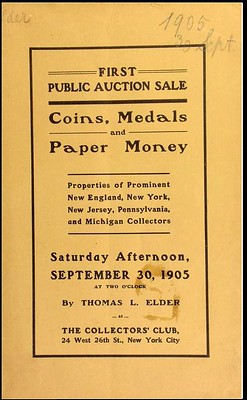 Yesterday afternoon they were gathered where Thomas L. Elder was putting up
several collections of coins, medals, and paper money at auction. There were 852
lots in all and they went at prices ranging from 12 cents up to $60. Sometimes the
bids advanced a cent at a time, and then again somebody would cooly say:
Yesterday afternoon they were gathered where Thomas L. Elder was putting up
several collections of coins, medals, and paper money at auction. There were 852
lots in all and they went at prices ranging from 12 cents up to $60. Sometimes the
bids advanced a cent at a time, and then again somebody would cooly say:
Fifteen dollars isn't too much for that.
Then good-bye,
some other bidder would say with a laugh, and from the jovial
auctioneer's lips dropped the perennial:
Fifteen, fifteen—sold at fifteen.
One man represented more than a score of customers, some of whom wanted some
one coin while others were anxious to get anything rare, whether coin or stamp or
bill. All were designated by pseudonyms invented to mask their identity, lest rival
agents discover them and supplant the services of the acting representative. There
was Texas,
who gobbled up anything and everything, paying fancy prices
without a protest.
Sold at three,
the auctioneer would announce.
Put it at four-fifty on Texas,
the agent would request. I save him 50 cents at
that.
Half a dozen times the bidders and the auctioneer fell into joking until they lost track of where they were. Then it might happen that they would go back a few numbers and sell them over again to make sure that no one was forgotten.
They had got to the section headed Hard times tokens,
&c., and an agent
generally referred to as New York
had secured at a fabulously cheap
price—$1.70 or something like that—a token catalogued as Low 163, Howell
Works Garden, a rose. Rev. Token. Very rare. Good.
He was so eager and elated
that he insisted on having the piece delivered at once. Just as he got it another
agent, New Jersey,
broke in:
Why, I made a mistake. I would have bid more for that coin. It was just an
oversight on my part. It's worth $5.
Oh say, give him a chance,
pleaded the auctioneer with New York.
Put it up
again—be a sport.
It's all right as far as I'm concerned,
replied New York,
scratching his head.
But how about the other man—the man I bought it for? I guess I'll have to stick to
it.
And to think it was just an oversight,
grumbled New Jersey
regretfully.
Among the rare pieces that caused the bids to leap upward dollars at a time was a
New Hampshire cent of 1776—a tiny bit of old copper honored in the catalogue
with the epithets priceless
and unique.
It was knocked down at $60.50 and the
buyer of it looked as if he had won a free pass to Paradise.
A United States silver dollar minted in 1794 brought $62.50, although defective, and the catalogue said that but for its defect it would have been cheap at $175.
In comparison it seemed to the outsider that a good thing was almost given away
when an Egyptian octodrachm,
from 260 B.C. went at $58.50. Thirteen dollars
and fifty cents was all that anybody cared to pay for a Roman gold coin that was
seventeen cycles old and was adorned with a splendid bust
of Antonius. One of
Uncle Sam's one-dollar pieces of gold but forty years old brought $21, and $25
was paid for a half-cent piece of 1841 that was dented on the edge, which the
catalogue said was extra rare.
All, in all, the sale realized about $2,500.
To read the complete article, see:
Catalogue of first public auction sale of coins, medals, and paper money. [09/30/1905]
(https://archive.org/details/catalogueoffirst00elde/)
VOCABULARY TERM: PARCEL-GILT
Here's another entry from Dick Johnson's Encyclopedia of Coin and Medal Terminology. I added an image of an ungilt version of the mentioned medal submitted by Dave Schenkman for an earlier article. Thanks again! Dave notes that "It is iron and not gilt, and I've never seen one that was gilt." -Editor
Parcel-gilt. Partly gilt; goldplated only on a part of a medallic item for the effect of a contrast of metals or their color. Parcel-gilt usually refers to objects that were originally firegilded – those that were only partially gilded in the first place, or were a part of this original gilding has worn off. Firegilding applied only a very thin layer of gold and this was susceptible to wearing away under many conditions (as being carried about or a container that abraded the piece). Parcel-gilt was applied to both base metal and precious metal items, often silver goldplate (vermeil); the contrast of silver sheen with a gold color, or both silver and gold on the same item was the effect their creator was trying to obtain.
In modern times an iron relic item was partially goldplated; the Deutschland Ballast Medal was struck in relic iron with an inner panel goldplated, leaving the wide rim the original iron color. This was described as parcel-gilt. However, by modern technology, such a process would be called stop-off. In contrast, two completely separate compositions in one medallic piece is called bimetallic.
To read the complete entry on the Newman Numismatic Portal, see:
Parcel-gilt
(https://nnp.wustl.edu/library/dictionarydetail/516458)
To read the earlier E-Sylum article, see:
A RELIC MEDAL OF THE GERMAN SUBMARINE DEUTSCHLAND
(https://www.coinbooks.org/esylum_v15n26a14.html)
WILLIAM FRANCIS SNEED JR. (1912-1979)
E-Sylum Feature Writer and American Numismatic Biographies author Pete Smith submitted this article on Florida coin dealer and promoter William Sneed. Thanks! -Editor
This week I was intrigued by an ad in The Orlando Sentinel for September 10, 1953. It invited
me to See The World's Largest Coin Collection
and to meet WORLD FAMOUS COIN
COLLECTOR
William E. Sneed. I was somewhat skeptical that his collection may not have
been the world's largest. I also suspect his status as a World Famous Coin Collector
was
extravagant self-promotion.
Since the event had been over for seventy years, I had to be content reading about Mr. Sneed. I was able to find plenty of newspaper articles about him.
William Francis Sneed, Jr. was born in Florida on December 5, 1912.
In 1931, William Francis Sneed, Sr. and Mary Elizabeth Morgan Sneed opened the Wilmary Hotel in Lakeland, Florida. I didn't find documentation but I suspect they named the hotel after themselves. William died in 1945. Mary died in 1963.
A large ad in the December 3, 1944, issue of The Tampa Tribune announced the formal opening of the W. F. Sneed, Jr. Chemical Laboratories in Lakeland, Florida. They produced janitorial supplies. They also sold a soap product called Sneed's Krystal Klear.
In 1946, William F. Sneed, Jr. was engaged to Janet Walker. On June 22, The Tampa Times
reported, He is now in the apartments business and chemical supply business in Tampa.
Jacksonville, Atlanta and Lakeland. On June 23, The Tampa Tribune reported,
Mr. Sneed was
graduated from Riverside Military Academy and the University of Florida. He is in the hotel
business in Atlanta and Lakeland.
On February 15, 1947, he married Mary Elizabeth Woodard
in Wilson, North Carolina.
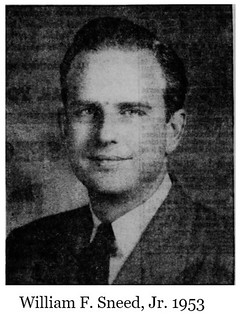 In June of 1953, William F. Sneed, Jr. joined the ANA as member 21221. In 1954, The Lakeland
Coin Club joined the ANA as member 22200. William F. Sneed, Jr. was listed as secretary.
In June of 1953, William F. Sneed, Jr. joined the ANA as member 21221. In 1954, The Lakeland
Coin Club joined the ANA as member 22200. William F. Sneed, Jr. was listed as secretary.
Sneed showed up in a July 22, 1953, article. A hotel man by profession, Sneed is considered
one of the nation's foremost authorities on ‘numismatics' the study of coins and bills. Even the
bankers come to him sometimes for advice.
One of the coins Sneed enjoys showing is the 1913 Liberty head nickel, of which only a few
exist. Another is a 1907 St. Gaudens $20 gold piece. This one is said to be unique – that is, the
only one like it in the world.
Other sources say that the McDermott 1913 nickel was on loan for
the display.
On November 24, 1953, the Tampa Bay Times reported that he had found a treasure worth
$625,000 near the mouth of the Suwannee River. This was in a barnacle crusted metal chest that
contained several thousand Spanish gold doubloons and silver pieces of eight dating back to
1737.
The story of the sensational find was repeated in many newspapers around the country.
On November 25, 1953, the Tampa Tribune reported that Sneed was now saying the report of the discovery was misinterpreted. He had about thirty coins of little value.
In 1956 he reported that he found a 1943 cent struck on a dime planchet. Also in 1956 he reported having a two-headed dime.
Sneed frequently set up his world-famous coin collection in a local bank, placed a large ad in the newspaper and invited the public to bring in coins to be evaluated. He also offered to buy coins from the public.
In 1956 Sneed exhibited his famous collection of rare coins at the West Palm Beach Federal Savings and Loan Association. He advertised there were approximately 5.000 coins in the collection. This would have been somewhat smaller than the world's largest.
In 1957, he advertised that he was Florida's Largest Coin Buyer.
He was charter member No. 3
of the Retail Coin Dealers Association.
Sneed ran frequent ads in Numismatic Scrapbook Magazine between 1953 and 1969. He had less frequent ads in Coin World in the late 60's. He offered predictions on the future of the coin market and reports of fakes being offered.
He reported there was a break-in at his office three times within 30 days in 1968. He did not mention loss of inventory, but business records were scattered about the floor.
In 1969, he reported that he had a possible 1943 copper penny and had sent it to New York for authentication. He reported that there are only four known copper pennies in existence. The topic came up again in 1967. He was quoted in The Tampa Tribune for February 9, 1967.
Also to clarify the records again, according to Miss Eva Adams, director of the U. S. Mint in
Philadelphia, there were
no
1943 copper cents struck at any of the U. S. Mints during 1943.
From time to time so-called
1943 copper cents have been found, but when tested turned out to
be nothing more than 1943 steel cents
that had been copper plated.
The Wilmary Hotel evolved into an apartment house for elderly residents who received meals
with their room. After 40 years, the hotel was considered old
and demolished in 1971.
In 1974, Sneed was offered an 1804 dollar that he determined was fake. He told the story to the
press. Details are sketchy,
the local numismatist explained. but it is believed that a shipment
of the 1804's was put aboard a British ship bound for Europe. That vessel must have met with
some sort of ill fate during the Atlantic crossing.
Only one thing is certain. Those silver dollars never made it to Britain, and only four remain.
Those were given to collectors at the time, and consequently saved from the unknown fate of the
others.
He told this story in 1974, twelve years after publication of The Fantastic 1804 Dollar. If he was one of the foremost authorities on numismatics, he had fallen a little bit behind with his reading. Sneed died on September 24, 1979.
I am unclear about his legitimate place in numismatic history. It appears that he was never a full-time dealer. He did business more by mail rather than at coin shows and did not conduct auctions or write for publication. He has little reason to be remembered.
If he was half as important as he claimed, he would still have been an important Florida dealer.
The digitization of old newspapers, including numismatic publications on the Newman Portal enable research on formerly obscure people and topics. Thanks, Pete! There is no shortage of interesting personalities in this hobby. -Editor
NUMISMAGRAM MEDAL SELECTIONS: FEBRUARY 4, 2024
Jeremy Bostwick with Numismagram forwarded these four medals from his most recent upload of new material to his site. For all of the new items, please visit https://www.numismagram.com/inventory. -Editor
102639 | FRANCE. Paris. International Expo bronze Award Medal. Issued 1900 as the official prize [awarded to F. Zerhau] (63mm, 101.66 g, 12h). By J.-C. Chaplain at the Paris mint. REPUBLIQUE FRANÇAISE, bust of Marianne right, wearing oak wreath; oak tree to left; cityscape of Paris in background to right // EXPOSITION UNIVERSELLE INTERNATIONALE, Victory flying left, head upturned right, holding wreath and palm frond, and bearing victor, holding torch, upon her back; view of the expo hall in background; in exergue, cartouche with F. ZERHAU. Edge: «cornucopia» BRONZE. Button 29; Wurzbach 7193. Choice Mint State. Olive-brown surfaces. $295.
Visited by more than 50 million visitors, the 1900 Paris World's Fair, styled in French as the Exposition Universelle, ran from 14 April to 12 November, occurring in conjunction with the games of the II Olympiad—also held in Paris. The theme of the expo was a celebration of the century that was and the century that would be. Some of the technological advancements that were exhibited included the diesel engine, electric cars, talking films, and dry cell batteries, with Art Nouveau given a spotlight and being introduced to the world.
To read the complete item description, see:
102639 | FRANCE. Paris. International Expo bronze Award Medal.
(https://www.numismagram.com/product-page/102639)
102697 | JAPAN & RUSSIA. Battle of Tsushima bronze Medal. Issued Meiji 38 (1905). Commemorating the final naval battle of the Russo-Japanese War (55mm, 78.69 g, 12h). Wreath and artillery shell before Japanese Army and Navy flags crossed in saltire; sakura blossoms around // Legend in four lines in Japanese (seal script) within circular maeander border; legend in Japanese (seal script) around; all within circular border of alternating anchors and stars. Edge: Plain. Cf. Smirnov 1343. Choice Mint State. Alluring brown surfaces, with a great glossy nature throughout; a powerful and rare piece. Includes original box of issue. Just the third time that we have had this impressive type, with the first being an even rarer version in silver pedigreed to the Virgil M. Brand Collection (which later sold in Stack's Bowers 2019 ANA auction [lot 21306], realizing a total of $5,280). Compare to similar examples in Westfälische Auktionsgesellschaft 46 (lot 2908) and 48 (lot 4169), which realized hammers of € 1,150 and € 750, respectively. $795.
Known in Japan as the Battle of the Sea of Japan, the Battle of Tsushima served as the final naval battle in the Russo-Japanese War, and was a clear Japanese victory. The battle has the distinction of being the only decisive engagement between modern steel battleship fleets, the last decisive naval battle in history, and the first in which the telegraph played an important role. The heavy losses suffered by Russia forced her to seek peace, with U.S. president Theodore Roosevelt instrumental in the a treaty later signed in Portsmouth, and for which he would later win the Nobel Peace Prize.
To read the complete item description, see:
102697 | JAPAN & RUSSIA. Battle of Tsushima bronze Medal.
(https://www.numismagram.com/product-page/102697)
102690 | GERMANY, RUSSIA & LATVIA. Fall of Riga cast bronze Medal. Issued 1917 (56mm, 59.40 g, 11h). By K. Goetz in München. RIGA 1917, Russian bear lying on its back right, pierced by sword and wounded by the internal and external conflicts of 1914 through 1917, indicated on each limb // DER / FLÜGELSCHLAG / DER ZEIT (the wingbeat of the times), hourglass, indicating time has expired, held by scythe; chaotic revolutionary forces below. Edge: Plain. Kienast 195; Jones, Dance of Death, 39. Choice Mint State. Virtually as cast, with warm brown surfaces. A scarce and popular type. $795.
Owing to its strategic position on the Gulf of Riga, the gulf's namesake city was of vital interest to its controlling Russian forces as well as those of the German Empire, who looked at it as a way to control the Baltic scene. If Germany were able to seize Riga, troops stationed near there could be then redeployed to the western front and France, where Germany believed the war would ultimately be decided. The battle was fought over three days at the beginning of September in 1917, with Germany eventually being victorious and capturing Riga, though the Russian 12th Army was able to escape and retreat. Internally, Russia herself was in turmoil, with Czar Nicholai II and the Romanov ruling family overthrown in February of that year and, just two months after the fall of Riga, the Bolshevik Revolution ("October" Uprising) would occur, sparking Russia's eventually fall to the hands of the Soviets. As indicated by Goetz on this medal, the Russian bear was bearing the wounds of multiple years' worth of internal and external conflicts.
To read the complete item description, see:
102690 | GERMANY, RUSSIA & LATVIA. Fall of Riga cast bronze Medal.
(https://www.numismagram.com/product-page/102690)
102658 | SWEDEN. Göteborg Tercentenary Anniversary Exhibition bronze Issued 1923. Commemorating the expo and the 300th anniversary of the city's founding (56mm, 75.96 g, 12h). By C. Milles for Sporrong & Co. JVBILEVMS VT STÄLLNINGEN GÖTEBORG, coat-of-arms of Göteborg (stylized lion rampant right, holding sword and shield; crown above) // Four gods (Minerva/Athena, Vulcan/Hephaistos, Mercury/Hermes, and Neptune/Poseidon advancing left, torsos and heads facing, and each holding attributes: book, gear, caduceus, and trident, respectively; in exergue, dolphin left. Edge: C C SPORRONG & Co. MKD 99 (type IIIa). Mintage: 1,800. Gem Mint State. Deep olive-brown surfaces. Great relief and texture. $195.
Known for figurative sculptures and large-scale fountains, Carl Milles was one of Sweden's most prominent artists. In addition to his other media, Milles also designed a number of medals capturing his sculpted, very modern style. On this medal, his distinctive style comes through clearly. Of note, the city of Göteborg recently celebrated its 400th anniversary last year.
To read the complete item description, see:
102658 | SWEDEN. Göteborg Tercentenary Anniversary Exhibition bronze Medal.
(https://www.numismagram.com/product-page/102658)
Another great selection of interesting and important medals. Thank you! -Editor
WBNA US CURRENCY SALE FIVE HIGHLIGHTS
The World Banknote Auctions U.S. Currency Sale 5 bidding begins February 9, 2024 at 10 AM PST. Consignment Director Ryan Baum sent along these highlights and comments. -Editor
Ryan writes:
"Colonial Currency has become popular again as we look ahead to our nation's 250th birthday in a couple of years. Although we have handled several Colonials, we have an unusual uncut New Jersey sheet of mixed denominations. This is not a remainder as all notes are signed and serial-numbered. We tried to figure out the logic behind the denominations and how it aggregates to a total value of 3 Pounds, 3 Schillings. Could the extra Schillings represent a 5% fee to the printer when cut?"
New Jersey March 25, 1776 Fr. NJ-175-180 PMG Extremely Fine 40 1/- to 15/- Shillings (Uncut Sheet)
Extremely Rare and Historic Uncut Sheet of 12 from New Jersey Issue of March, 1776.
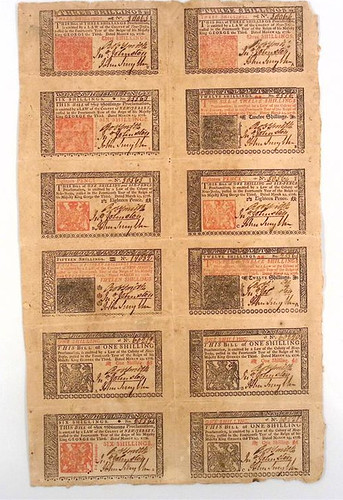 Here is an absolutely wonderful and extremely rare uncut 12-subject sheet from the time of George Washington, the Declaration of Independence and the Revolutionary War. Uncut sheets of Colonial and Continental Currency range from very scarce to uncollectible. This sheet, according to our research, comes close to the uncollectible category. A complete single pane of this issue (two uncut sheets) was in the F.C.C. Boyd estate, later purchased in its entirety by John J. Ford and sold in October 2004 in part VI of the Ford Collection (lot 541, where it was called by the cataloger "the first we have seen" and "a grand sheet"). This sheet has a slightly different layout (see below), and appears to be higher grade and of better appearance. We are not aware of any other uncut sheets existing of this issue, and if they do, none seems to have appeared at major auction in the past few decades.
Here is an absolutely wonderful and extremely rare uncut 12-subject sheet from the time of George Washington, the Declaration of Independence and the Revolutionary War. Uncut sheets of Colonial and Continental Currency range from very scarce to uncollectible. This sheet, according to our research, comes close to the uncollectible category. A complete single pane of this issue (two uncut sheets) was in the F.C.C. Boyd estate, later purchased in its entirety by John J. Ford and sold in October 2004 in part VI of the Ford Collection (lot 541, where it was called by the cataloger "the first we have seen" and "a grand sheet"). This sheet has a slightly different layout (see below), and appears to be higher grade and of better appearance. We are not aware of any other uncut sheets existing of this issue, and if they do, none seems to have appeared at major auction in the past few decades.
This sheet includes the six initial denominations of the March 25, 1776 issue. The latest issue of Eric P. Newman's The Early Paper Money of America highlights the complicated background of this issue. The issuance of these notes traced its authorization back to 1768, when £ 100,000 in bills of credit were to be issued subject to the Crown's consent, along with an additional £ 25,000 to replace worn out bills of previous issues. The Crown never moved to authorize the issuance and according to Newman; it wasn't until after the American Revolution began that these Bills of Credit were issued for circulation and made Legal Tender according to the Act of September 20, 1776.
Even though single notes of this issue are relatively common in all grades, an uncut sheet (or fraction thereof) is a different story. Uncut Colonial Sheets from New Jersey are seen much more infrequently than those from, for example, Pennsylvania and Rhode Island. Ford had just three uncut sheets from New Jersey, all of which were part of the F.C.C. Boyd estate. Seeing this uncut sheet brings up a couple of questions regarding printing and numbering. For example, the serial numbers follow no logical pattern, and there are an uneven number of notes spread out over the six denominations: 3x 1 Shilling, 2x 18 Pence, 2x 3 Shillings, 2x 6 Shillings, 2x 12 Shillings and 1x 15 Shillings. This is a different sheet layout than the pane in the Ford collection, which featured a 30 Shillings note instead of an additional 6 Shillings. Each note carries three handsigned signatures: Robert Smith, Jonathan Johnston and Joseph Smith. An exceptional item worthy of the finest collection of Colonial Paper Money. PMG mentions "Splits; previously mounted".
To read the complete lot description, see:
New Jersey March 25, 1776 Fr. NJ-175-180 PMG Extremely Fine 40 1/- to 15/- Shillings (Uncut Sheet)
(https://bid.worldbanknoteauctions.com/lots/view/4-CJ2045/new-jersey-march-25-1776-fr-nj-175-180-pmg-extremely-fine-40-1-to-15-shillings-uncut-sheet)
Ryan writes:
"Among Nationals we were fortunate to receive an elusive Alaska note. While many collectors view Nevada as a difficult state, Alaska is even rarer. Interestingly this note also has a connection to California given the founders were from Santa Barabara and decided to follow the Klondike Rush to Alaska. A two digit serial number is an added treat to this note."
Juneau, AK 1929 Ty. Fr. 1802-1 The First NB CH# 5117 PMG Choice Fine 15 20 Dollars
For a serious collector of national banknotes, here is a note from the rarest of the 50 states, Alaska, and from its State Capital as well. Only three national banks were chartered in Alaska before 1935 with this bank being the first. The First National Bank of Juneau chartered in 1898 during the peak of the Kondike Gold Rush. The initial founders rushed to Alaska from Santa Barbara, CA, where they had already engaged in banking. They founded the bank with $50,000 in capital of which $12,500 was used to purchase bonds to secure banknote circulation. Only in 1932 did the bank raise its circulation to $50,000 shortly before the end of the note issuing period, a still surprisingly small number for a bank whose assets were nearly $1.5 million.
The First National Bank of Juneau issued only 8,099 in small size notes of which only 14 notes are known in the current census with this new note raising the census to 15, still far too few to satisfy the consistent demand for notes from the Last Frontier. Although the note certainly shows circulation usage, it is a pleasing Choice Fine grade and low two digit serial number. With notes from this bank only appearing at auction less than every other year, now is a rare opportunity for a collector who truly aspires to collect all fifty states. PMG mentions "Minor repair".
To read the complete lot description, see:
Juneau, AK 1929 Ty. Fr. 1802-1 The First NB CH# 5117 PMG Choice Fine 15 20 Dollars
(https://bid.worldbanknoteauctions.com/lots/view/4-CJ20BH/juneau-ak-1929-ty-fr-1802-1-the-first-nb-ch-5117-pmg-choice-fine-15-20-dollars)
Ryan writes:
"Moving to warmer climates, we have a beautiful proof of a Republic of Hawaii $100 Silver Certificate. Unlike the earlier issue during the monarchy, this was intended to be issued by the brief independent republic but was annexed by the United States before the notes could be issued."
Hawaii 1895 P-15pp1 PMG Superb Gem UNC 67 EPQ 100 Dollars (Front Proprietary Proof)
A proof for a note that could have been but never was. While many collectors are familiar with Hawaii's issued coins, few are aware of its paper money history. This proof is of what was to have been a $100 Silver Certificate printed by American Banknote Compnay and issued during the brief Republic of Hawaii, a four year period from 1894 following the deposing of the last Hawaiian Monarch to 1898 when annexed by the United States. The primary design of this note was based on the same vignettes and layout of the 1879 $100 Silver Certificate series during the time of the Monarchy. The text and designs in the 1895 design are streamlined with more straight-line and linear layout than the earlier curved text and designs. As a tribute to Hawaii's local and global position in trade, the horse and cattle represent agriculture while the globe displays major shipping lanes converging in what is now Panama. This proof makes a significant addition to any collector looking to move beyond typical American type notes and is a true crossover of U.S. and World Currency.
To read the complete lot description, see:
Hawaii 1895 P-15pp1 PMG Superb Gem UNC 67 EPQ 100 Dollars (Front Proprietary Proof)
(https://bid.worldbanknoteauctions.com/lots/view/4-CJ2077/hawaii-1895-p-15pp1-pmg-superb-gem-unc-67-epq-100-dollars-front-proprietary-proof)
Ryan writes:
"Another note I enjoyed working with was a $500 Confederate States note with vivid colors unlike the later issues of the same note. This note is a CSA type-note of its own with the Stars and Bars battle flag."
Confederate States 1864 T-64 PCGS Choice About UNC 55 PPQ 500 Dollars
A fully original example of this popular Confederate $500 issue with particular strong color for the type. As the American Civil War raged on the South had increasingly difficulty acquiring inks, including the pink/red needed for its banknotes. As a result, later printings of this issue tend to be very faded with little color, which is how this type is typically seen. Any example with strong color, such as this one, is much scarcer and worth a premium bid.
To read the complete lot description, see:
Confederate States 1864 T-64 PCGS Choice About UNC 55 PPQ 500 Dollars
(https://bid.worldbanknoteauctions.com/lots/view/4-CJ208H/confederate-states-1864-t-64-pcgs-choice-about-unc-55-ppq-500-dollars)
Ryan writes:
"Another interesting note is a National Gold Banknote in well circulated condition. This note's condition demonstrates how these notes were preferred in California for several decades despite the greenback getting back to par by the end of the 1870s. This note is also on the first national bank to charter in California with an 1870 date and is perfect for someone expanding into gold banknotes."
San Francisco, CA 1870 Fr. 1136 First National Gold Bank CH# 1741 PMG Good 4 NET 5 Dollars
National Gold Banknotes were the workhorses of California's economy in the 1870's. Here's a survivor that illustrates that quite well, as this 5 Dollar from the First National Gold Bank of San Francisco shows. Despite having spent considerable time in circulation, most of the design elements remain clear, and the overall eye-appeal is better than the technical grade would suggest. The pen signatures remain visible and the color of the note is strong. Overall a pleasing yet what should be an affordable example of one of the most iconic and popular issues of United States currency. PMG mentions "Tape; internal splits"
To read the complete lot description, see:
San Francisco, CA 1870 Fr. 1136 First National Gold Bank CH# 1741 PMG Good 4 NET 5 Dollars
(https://bid.worldbanknoteauctions.com/lots/view/4-CJ20CG/san-francisco-ca-1870-fr-1136-first-national-gold-bank-ch-1741-pmg-good-4-net-5-dollars)
See an article elsewhere in this issue for more on the National Gold Banks. -Editor
NUMISMATIC NUGGETS: FEBRUARY 4, 2024
Here's a selection of interesting or unusual items I came across in the marketplace this week. Tell us what you think of some of these. -Editor
Titus Sestertius
Titus, 79-81. Sestertius (Ae, 34.34 mm, 25.73 g) uncertain mint, Rome or Thrace, 80-81. IMP T CAES DIVI VESP F AVG P M TR P P P COS VIII. Laureate head of Titus right. Rev. Mars nude, wearing flowing cloack on the left shoulder and crested helmet, advancing right with the right leg onward, holding long spear in the right hand and trophy in the left hand over the shoulder, S C to left and right sides. RIC II.1, 499. RPC II, 502. Cohen 203 corr; BMCRE 310. Dark patina. Extremely Fine
From the February 2024 Astarte Web Auction 3. Interesting reverse design with a single striding figure. -Editor
To read the complete lot description, see:
Titus, 79-81. Sestertius
(https://www.biddr.com/auctions/astarte/browse?a=4267&l=5045661)
1777 Swiss-French Solothurn Alliance Renewal Medal
SWITZERLAND. Solothurn. City and Canton. Gilt bronze medal 1777 sworn the alliance between Louis XVI of France and the Swiss Confederates, sworn in Solothurn. (Gilt Bronze, 53.78 mm, 50.21 g) 1777, by K. J. Schwendimann. LUDOVICUS XVI REX CHRISTIANISS Bust to right. Rev. HELVETIOS NOBIS SOCIOS NOVA FOEDERA IUNGANT Gallia and Helvetia shaking hands in front of a sacrificial altar flame with an enthroned Minerva sitting atop a nearby column; in exergue SOLODVRI XXV AVG / MDCCLXXVII. Swiss medals 89 (bronze). Sehr selten / Very rare. Sehr schön-vorzüglich / Very fine-extremely fine.
An alliance had already been concluded between the Confederation and the French king under Louis XIV in 1663, which primarily focussed on military aspects. Due to internal disputes between the cantons, this alliance was not renewed in 1715. It was not until Louis XVI attempted to reach an agreement again, which was achieved in 1777. The renewal was celebrated on 25 August in Solothurn, the official residence of the French ambassador, to which this medal refers.
Another lot from the February 2024 Astarte Web Auction 3. Nice medal with a high relief obverse bust. -Editor
To read the complete lot description, see:
SWITZERLAND. Solothurn. City and Canton.
(https://www.biddr.com/auctions/astarte/browse?a=4267&l=5045750)
1836 Half Dime
LM-3,R.1, 3/INVERTED 3 CAC. A scarce variety in higher grades with lustrous surfaces and full strike. A 65 non cac not as nice as this one in some ways brought 8400! Great value.
Great coin. From the website offerings of Harry Laibstain Rare Coins. -Editor
To read the complete item description, see:
1836 H10C LARGE 5C LM-3,R.1, 3/INVERTED 3 PCGS MS63 CAC
(http://hlrc.com/Inventory/CoinViewer?id=871207006&c=23)
De La Rue Advertising Note
Thomas De La Rue & Co. Ltd., an advertising note for Bank Notes and Postage Stamps
, ND (c. early 20th century), serial number 00,266102H, with the same design on reverse, in a different colour, good extremely fine to about uncirculated, rare £ 200-£ 260
Nice example of the banknote printer's promotional work. From Noonan's February 29, 2024 Leap Year sale. -Editor
To read the complete lot description, see:
Thomas De La Rue & Co. Ltd., an advertising note for Bank Notes and Postage Stamps
(https://www.noonans.co.uk/auctions/calendar/740/catalogue/479491/)
Super Bowl LVIII Flip Coin
Super Bowl LVIII (58) starts with the Flip Coin! This is the same coin that will be used for the Official Coin Toss to start the game. This is a unique limited edition minted coin measuring 39mm in diameter and plated with .999 fine silver then selectively plated with 24kt gold. The Flip Coin is minted on one side with the official Super Bowl LVIII logo as well as the commissioners signature and the other side is minted with the dueling logos of the Super Bowl teams. Each Flip coin is individually numbered on the coin, protected in a clear capsule to preserve its condition, accompanied by a matching numbered certificate of authenticity and delivered in a 4"x6" suede booklet only used for this coin. This coin is a limited edition of only 10,000 and officially licensed by the NFL. Proudly made in the USA by The Highland Mint!
And don't forget the Highland Mint's super bowl coin flip "coin." -Editor
To read the complete item description, see:
SUPER BOWL LVIII OFFICIAL GOLD AND SILVER 2-TONE FLIP COIN
(https://www.highlandmint.com/products/49ers-v-chiefs-super-bowl-lviii-official-gold-and-silver-2-tone-flip-coin)
GEORGE OHR: THE MAD POTTER OF BILOXI
We've periodically highlighted the interesting and unusual numismatic work of George E. Ohr - his six "double-sided clay coins bearing pictures, words, and numbers combined to form twelve messages, all crudely sexual." A new Smithsonian article delves into Ohr's history and a new museum showcasing his pottery work. -Editor
Just a few blocks from shore, a five-story wooden pagoda
labeled BILOXI ARTPOTTERY
towered above the train tracks that ran across Delauney Street. Approaching it, a visitor saw hand-lettered signs. One read: Get a Biloxi Souvenir, Before the Potter Dies, or Gets a Reputation.
Another proclaimed: Unequaled unrivaled—undisputed— GREATEST ARTPOTTERON THE EARTH.
Stepping inside, a curious tourist found a studio overflowing with pots. But they were not your garden variety. These pots featured rims that had been crumpled like the edges of a burlap bag. Alongside them were pitchers that seemed deliberately twisted and vases warped as if melted in the kiln. And colors! In contrast to the boring beiges of Victorian ceramics, these works exploded with color—vivid reds juxtaposed with gunmetal grays; olive greens splattered across bright oranges; royal blues mottled on mustard yellows. The entire studio seemed like some mad potter's hallucination, and standing in the middle of it all was the mad potter himself.
 Viewed from a distance across his cluttered shop, George Ohr didn't look mad. With his huge arms folded across his dirty apron, he looked more blacksmith than potter. But as they got a bit closer, customers could glimpse the 18-inch mustache he had wrapped around his cheeks and tied behind his head. And there was something in Ohr's eyes—dark, piercing and wild—that suggested, at the very least, advanced eccentricity. If the pots and the man's appearance did not prove lunacy, his prices did. He wanted $25—the equivalent of about $500 today—for a crumpled pot with wacky handles.
Viewed from a distance across his cluttered shop, George Ohr didn't look mad. With his huge arms folded across his dirty apron, he looked more blacksmith than potter. But as they got a bit closer, customers could glimpse the 18-inch mustache he had wrapped around his cheeks and tied behind his head. And there was something in Ohr's eyes—dark, piercing and wild—that suggested, at the very least, advanced eccentricity. If the pots and the man's appearance did not prove lunacy, his prices did. He wanted $25—the equivalent of about $500 today—for a crumpled pot with wacky handles. No two alike,
he boasted, but to most customers each looked as weird as the next. No wonder that as the new century began, thousands of the colorful, misshapen works collected dust on Ohr's shelves, leaving the potter mad, indeed, at a world that failed to appreciate him. I have a notion . . . that I am a mistake,
he said in an interview in 1901. Yet he predicted, When I am gone, my work will be praised, honored, and cherished. It will come.
Some 85 years after his death, the self-styled Mad Potter of Biloxi
will be praised and honored as he predicted. Two years from now, Ohr's startling ceramics will be showcased in a new $25 million Biloxi arts center designed by architect Frank O. Gehry, whose swirling silver Guggenheim Museum put Bilbao, Spain, on the cultural map. The Ohr-O'Keefe Museum of Art, a Smithsonian Affiliate, is named in honor of former Biloxi mayor Jeremiah O'Keefe and his late wife, Annette. Their family's $1 million gift helped establish the museum, now housed in a small building downtown, in 1998.
The new facility, scheduled to be completed in January 2006, will be nestled in a four-acre grove of live oaks overlooking the Gulf. As America's first museum dedicated to a single potter, the complex will call attention to an art more often seen as craft. And if yet another story of an artist ahead of his time
sounds clichéd, the resurgence of George Ohr will cap one of the art world's most remarkable comebacks. For although his work is now in such museums as New York's Metropolitan Museum of Art and the Smithsonian's National Museum of American History, until the late 1970s, the only place to see an Ohr pot was in a garage behind a Biloxi auto shop—in a crate.
in both museum and private collections, nearly every Ohr pot is dated to the same short period: 1895-1905. During this decade, Ohr labored at a feverish pace, turning out thousands of amazing, outrageous, wonderful pots. Just as Cézanne was breaking up the plane of the painter's canvas, Ohr was shattering the conventions of ceramics. He made pitchers whose open tops resembled yawning mouths. He threw slim, multitiered vases with serpentine handles. He lovingly shaped bowls into symmetrical forms, then crumpled them as if to thumb his nose at the art world. He fired his works into kaleidoscopic colors that only a few years later would be called fauve—for the wild
hues of Matisse and other Fauvists. And almost a decade before the Cubists added print to their canvases, Ohr scrawled on his ceramics with a pin.
Locals were not amused, and many considered their native mud dauber certifiably insane. More likely, Ohr was just ahead of his time, in promoting his work as well as crafting it. Decades before Salvador Dali began his self-aggrandizing antics, Ohr asked a reporter, You think I am crazy don't you?
Assuming a sober demeanor, the mad
potter confided, I found out a long time ago that it paid me to act this way.
It did not pay well, however. Ohr was a notoriously bad businessman. He put shockingly high prices on his favorite pots because he simply could not bear to part with them. On those rare occasions when customers paid the asking price, Ohr would chase them down Delauney Street, trying to talk them out of the purchase. Ohr didn't seem to care that he made so little money. Every genius is in debt,
he said.
By the turn of the century, Ohr had begun to get a little respect if not much success. Asurvey of ceramics published in 1901 called his body of work in some respects, one of the most interesting in the United States.
Although Ohr exhibited his pots around the country and in Paris, the prizes always went to more traditional pottery. Ohr's only medal, a silver for general work, came at the 1904 Louisiana Purchase Centennial Exhibition in St. Louis. Still, he did not sell a single piece there. Even his few admirers misunderstood him.
See the complete article online for more, including how antiques dealer James Carpenter purchased Ohr's unsold inventory. -Editor
After three more summers of negotiations, for a price rumored to be closer to the lower figure, Carpenter moved Ohr's treasures to New Jersey, where they began trickling onto the marketplace.
 Meanwhile, the art world had begun catching up to Ohr. During the 1950s, a school of Abstract Expressionist ceramics had flowered, creating free-form works that looked more like sculpture than pottery. Artists, including Jasper Johns and Andy Warhol, bought Ohr's pots, as did several collectors, though the curator of ceramics at the Smithsonian's National Museum of American History protested Ohr's inclusion in a show in 1978, calling him
Meanwhile, the art world had begun catching up to Ohr. During the 1950s, a school of Abstract Expressionist ceramics had flowered, creating free-form works that looked more like sculpture than pottery. Artists, including Jasper Johns and Andy Warhol, bought Ohr's pots, as did several collectors, though the curator of ceramics at the Smithsonian's National Museum of American History protested Ohr's inclusion in a show in 1978, calling him just plain hokey.
Only in 1984, when Ohr pots appeared in paintings by Johns at New York's Leo Castelli Gallery, did praise and critical esteem begin to flow. After a series of one-man shows of Ohr's work, collectors such as Steven Spielberg and Jack Nicholson purchased pieces and drove prices up. Today, the same pots scorned a century ago sell from $20,000 to $60,000 each. Back in 1900, when his pots were barely selling at all, exasperated exhibition organizers would ask Ohr to put a value on his works. Worth their weight in gold,
he would answer. In retrospect, he sold himself short.
To read the complete article, see:
The Mad Potter of Biloxi
(https://www.smithsonianmag.com/arts-culture/the-mad-potter-of-biloxi-106065115/)
To read the earlier E-Sylum article, see:
GEORGE OHR'S PROVOCATIVE CLAY TOKENS
(https://www.coinbooks.org/v24/esylum_v24n50a23.html)
NUMISMATIC NUGGETS: MAY 7, 2023 : George Ohr Token
(https://www.coinbooks.org/v26/esylum_v26n19a24.html)
THE NATIONAL GOLD BANKS
Stack's Bowers Currency Auction Associate Bradley C. Trotter published an article about the National Gold Bank notes. -Editor
In the western United States, specifically California, hard money remained the norm in commerce, even after paper money had become more acceptable in the East and Midwest. Silver and gold were king, and other forms of currency that circulated in the East found no welcome in California. Distrust among the early pioneers that came seeking their fortunes in the gold fields of California directly influenced the prohibition of banks and other institutions from issuing paper money in the state.
However, in 1870 a compromise was made at the federal level, one that reflected the hard money preferences of California and the West Coast. The Currency Act of July 12, 1870, authorized the creation of special National Gold Banks that had the authority to issue National Bank Notes redeemable in gold coin. From 1871 through 1883 a total face value of $3,465,240 across almost 200,000 notes was issued to 10 banks in California and Massachusetts.
Issued in denominations of $5 through $500, these notes reflected their counterparts that were backed by bonds but differed notably in an aesthetic sense. Printed on bright orange-hued paper (with some exceptions) and bearing a shared vignette that illustrates a collage of gold coins against a gold-hued reverse, these notes were strikingly distinctive.
Nine banks in California would be chartered under the program. The largest of these, the First National Gold Bank of San Francisco, accounts for the majority of surviving notes today, while a scattering of notes are recorded on the remaining charters. $50s & $100s are practically non-existent and these attract significant attention when one crosses the auction block or appears for sale. In 2018 we sold the finest known $50 National Gold Bank Note, an Fr. 1160 from the Joel R. Anderson Collection for $384,000.
Across the country in Massachusetts, the Kidder National Gold Bank of Boston never issued any notes for circulation, and thus likely returned them to the Treasury where they were redeemed and later destroyed. A pair of specimens are known, but these are radically different aesthetically from their California counterparts on account of the bright gold tint and the banner National Gold Note
displayed across the top margin. As these were just specimens, however, the true appearance of an example from the Kidder National Gold Bank remains unknown.
Today such notes are rare in any condition and are fiercely pursued by collectors. With just under 600 examples known across all denominations, the vast majority of survivors are below the grade of Very Fine or suffer from impairments. Even impaired examples bring strong bids, a fact that speaks to the popularity of this California oddity.
Whenever I learn a new tidbit of numismatic information, especially U.S. numismatics, I'm...
1) delighted to learn a new fact, and
2) chagrined that I didn't know it already. DUH! Have you NOT been paying ATTENTION all these years?? Maybe I knew it and just forgot it. Yeah, that's the ticket - my first Senior Moment... -Editor
To read the complete article, see:
A BRIEF PRIMER OF A CALIFORNIA ODDITY: THE NATIONAL GOLD BANK NOTE
(https://stacksbowers.com/a-brief-primer-of-a-california-oddity-the-national-gold-bank-note/)
COIN GIFT HOLDERS
On the PCGS site, Victor Bozarth published an article about Coin Gift Holders. Here's an excerpt; see the complete article online. The image shows gift boxes intended for holding gold coins. -Editor
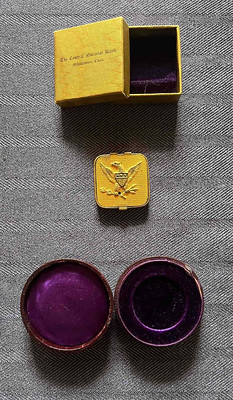 In the past I've written about the importance of original packaging on numismatic merchandise. What about the gift boxes, cards, envelopes, and other mediums used when gifting a coin?
In the past I've written about the importance of original packaging on numismatic merchandise. What about the gift boxes, cards, envelopes, and other mediums used when gifting a coin?
The boxes, cards, and envelopes that coins were originally gifted in are also of immense importance – and sometimes collector value! Not only were a great many of these packaging items disposed of over the decades, but also the process of discarding this packaging left the coin(s) inadvertently damaged.
Much like original U.S. commemorative coin packaging has value, these coin-related items are highly collectible, and some are quite valuable too.
I've managed to prevent the original U.S. commemorative packaging from being disposed of numerous times with just this warning. Was that important? Here's the deal: it is not just the packaging that might be valuable, but also the information that packaging might provide us.
What about the gift boxes, cards, or envelopes? Was there a message or note included? Did a favorite grandfather, aunt or uncle, or family friend personally gift the item to you? Maybe it was gifted to a parent or grandparent from a distant relative you never got to meet? What happened to those items? Oh, the stories those mundane boxes might tell… Who doesn't love a story?
As a professional numismatist, I've encountered coins, sometimes in gift boxes, over the decades. Often, these coins were in an envelope or even a small purse that included a note with a date and a name. Many times, the day and month were listed with just the initials of the recipient and / or gifter.
To read the complete article, see:
The Evolution of Coin Gift Holder
(https://www.pcgs.com/news/the-evolution-of-coin-gift-holders)
SOTHEBY'S REVAMPS BUYER'S PREMIUMS
Axios reports on a major change in auction price structure announced by Sotheby's. I've never cared much for the gimmick of Buyer's fees, although it's a minor inconvenience for bidders who don't mind the math. Time will tell if competitors and markets in general follow Sotheby's lead. See the complete article online for more, particularly if you're a seller. -Editor
 The single most annoying and opaque aspect of buying and selling items at auction is about to get a lot more pleasant and transparent — at least at Sotheby's, which unveiled a major transformation of its commission structure on Thursday.
The single most annoying and opaque aspect of buying and selling items at auction is about to get a lot more pleasant and transparent — at least at Sotheby's, which unveiled a major transformation of its commission structure on Thursday.
Why it matters: Buyers and sellers alike have been frustrated for decades at the way in which the amount they end up paying (or receiving) can differ significantly from the hammer price in the auction room.
- Those differences — effectively, the amount of the transaction that Sotheby's takes for itself — have risen steadily over the years. Now, they are going to fall to a multi-decade low after May 20.
- Thursday's announcement from Sotheby's represents a major reset — and is likely to put huge pressure on Christie's to follow suit. (Christie's declined to comment to Axios on what they may or may not do.)
By the numbers: For a work hammered at $1 million, Sotheby's gross profit is going to fall 32% from $370,000 to $250,000.
What they're saying: "The reduction in the Buyer's Premium will incentivize more bidding from clients and result in higher hammer prices for sellers," said Sotheby's CEO Charles Stewart in announcing the move.
The bottom line: This is a very aggressive move from Sotheby's owner, French telecoms billionaire Patrick Drahi, and one that's aimed squarely at gaining market share. It's likely to be welcomed by collectors around the world.
To read the complete article, see:
2. Auction pricing is about to become a lot more transparent
(https://www.axios.com/newsletters/axios-markets-e0c7c425-ce32-4051-94ce-3f05f779b3f5.html)
LOOSE CHANGE: FEBRUARY 4, 2024
Here are some additional items in the media this week that may be of interest. -Editor
Michael Garofalo published a Greysheet Featured Article about the creation of Hermon Atkins MacNeil's Standing Liberty Quarter. Here's an excerpt - see the complete article online. -Editor
Some numismatic dealers and researchers like to infer that Standing Liberty Quarters, struck between 1916 and 1930, is shrouded in a veil of mystery or controversy. Let's explore these so-called controversies to see if they have withstood the test of time.
In 1916, there were three coins—the current and circulating Dime, Quarter, and Half Dollar—that each had been struck for 25 years. The U.S. Mint's Chief Engraver, Charles E. Barber, had designed all of them. Each of Barber's coin denominations shared the same obverse, and the reverse of the Quarter and Half Dollar shared a common reverse. The Dime had a much simpler reverse but none of the designs were awe-inspiring, even by 19th Century standards.
The Mint Director had invited a number of accomplished artists to offer new and more artistically beautiful designs than Barber's stodgy Miss Liberty. Of all of the designs submitted for the three coins, the works of two sculptors were selected for these three coins. Adolph A. Weinmans' designs were chosen for the Dime (Mercury Dime) and for the Half Dollar (Walking Liberty). Hermon Atkins MacNeil's design was selected for the Quarter. The selections were chosen by Treasury Department officials in February of 1916.
MacNeil was born in Massachusetts in 1866. Early in his artistic career he studied art in Paris and, after winning an art scholarship, he went to Rome for further study. MacNeil was primarily a sculptor and he created numerous life size sculptures of Native Americans in order to portray events in their lives.
To read the complete article, see:
The Controversial Standing Liberty Quarters
(https://www.greysheet.com/news/story/the-controversial-standing-liberty-quarters)
I'll bet all bibliophiles envision their dream library, but life and finances get in the way of making it a reality. Some have better luck. Here's a Wall Street Journal article about Austin-based hedge fund manager who went all out on a library remodel. -Editor
 The year 2022 was one of many firsts for 59-year-old entrepreneur and hedge-fund manager Mohnish Pabrai. It was the year he celebrated one year of his company's relocation from California to Austin, moved into his new home in Austin's West Lake Hills, and made the decision to work exclusively from home.
The year 2022 was one of many firsts for 59-year-old entrepreneur and hedge-fund manager Mohnish Pabrai. It was the year he celebrated one year of his company's relocation from California to Austin, moved into his new home in Austin's West Lake Hills, and made the decision to work exclusively from home.
At the time, Pabrai's library, from where he worked, was a makeshift space upstairs that could hardly accommodate his enormous book collection. With a view to expand the footprint and give the room some character, he set about finding an interior designer who could help him realize his vision.
Because my previous library in California had proved too small, we more than doubled the capacity of our Austin one. I keep buying books, but I don't think we'll run out of room for decades to come,
says Pabrai.
I love the custom millwork and marble countertops. In my dream numismatic library, lockable drawers would hide standard coin-show sized exhibit cases where I could plan, arrange and display exhibits of collection highlights. Blue is my favorite color, so of course I like this room. The view is great, but you don't want to sun the book spines. The adjoining bedroom has no windows, so rare volumes could be shelved there. This is a reader's library, though. -Editor
To read the complete article, see:
His Decision to Go Remote Called for a $180,000 Library Remodel
(https://www.wsj.com/real-estate/luxury-homes/his-decision-to-go-remote-called-for-a-180-000-library-remodel-a2bc989a)


